
- Home
- Travel Packages
- Top Destination
-
Travel Attraction
By Category
Top Attraction

- Travel Agents
- Car Rentals
- Hotels

About Ocean Park Ocean Park is a marine-themed amusement park located in Hong Kong. It covers an area of 91.5 hectares and is divided into two main areas: The Waterfront and The Summit. The park offers a wide range of attractions, including thrill rides, animal exhibits, marine shows, and educational programs. Location and Geographical Overview Ocean Park is situated on the southern side of Hong Kong Island, overlooking the South China Sea. It is easily accessible by public transport, with bus and MTR (Mass Transit Railway) options available for visitors. Opening and Closing Time Ocean Park is open from 10:00 am to 6:00 pm on weekdays and from 10:00 am to 7:00 pm on weekends and public holidays. However, it is always best to check the official website for any changes in operating hours. Entry Fee The entry fee for Ocean Park varies depending on the age of the visitor and any additional services or attractions they wish to access. There are also discounts available for seniors, children, and local residents. Species-Flora/Fauna Availability Ocean Park is home to a wide variety of species, both flora and fauna. Visitors can see animals such as giant pandas, dolphins, sea lions, and many more. The park also has a botanical garden with a diverse collection of plants and trees. Activities Performed There are plenty of activities to enjoy at Ocean Park, including thrill rides like roller coasters and water slides, animal encounters, marine shows, educational programs, and live entertainment. Visitors can also enjoy dining and shopping options throughout the park. Jeep Safari Charges Ocean Park offers a jeep safari experience for visitors to explore the park and see some of the animals up close. The charges for the jeep safari vary depending on the duration of the tour and any additional services included. Age Criterion and Entry Fee The entry fee for Ocean Park is based on the age of the visitor. There are separate rates for males, females, and children. Senior citizens may also qualify for discounted admission. It is advisable to check the official website for the most up-to-date pricing information. Senior Citizen Facilities Ocean Park provides various facilities for senior citizens, including designated rest areas, accessible pathways, and discounts on admission tickets. There are also special programs and events tailored for older visitors to enjoy. Best Time to Visit The best time to visit Ocean Park is during the cooler months of the year, typically from October to April, to avoid the heat and humidity of Hong Kong's summers. Weekdays are generally less crowded than weekends and holidays. Nearby Places to Visit There are several attractions near Ocean Park that visitors may want to explore, such as Repulse Bay, Stanley Market, and Hong Kong's famous theme park, Disneyland. These places offer a variety of sights, shopping, and dining options. Vehicle Parking Facility Ocean Park provides ample parking facilities for visitors arriving by car. There are designated parking lots available near the entrance of the park, with convenient access to the main areas and attractions. Rules and Regulations Visitors to Ocean Park are required to follow certain rules and regulations to ensure the safety and enjoyment of all guests. These include guidelines for behavior, dress code, prohibited items, and restrictions on activities within the park. How to Reach and Other Related Information Visitors can reach Ocean Park easily by taking public transportation, such as buses or the MTR. The park is well-connected to other parts of Hong Kong, making it convenient for tourists and locals alike. For more information on directions, tickets, and park policies, visitors can visit the official Ocean Park website or contact the park directly.
Explore More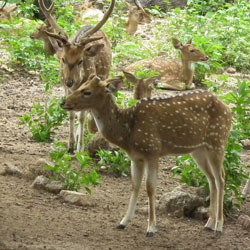
About Nehru Zoological Park Nehru Zoological Park, located in Hyderabad, Telangana, is one of the largest zoos in India. It covers an area of 380 acres and is home to a wide variety of species, both flora, and fauna. The zoo was established in 1959 and is named after Jawaharlal Nehru, the first Prime Minister of India. Location and Geographical Overview Nehru Zoological Park is situated near Mir Alam Tank in the Bahadurpura area of Hyderabad. The park is surrounded by lush greenery and offers a serene environment for both visitors and the animals residing in the zoo. Open and Closing Time The zoo is open to visitors from 8:00 am to 5:00 pm every day of the week, including public holidays. Entry Fee The entry fee for Nehru Zoological Park is INR 50 for adults and INR 30 for children (3-10 years). Foreign tourists are charged INR 100 for entry. Species-Flora/Fauna Availability Nehru Zoological Park houses a diverse range of wildlife, including mammals, birds, reptiles, and amphibians. Visitors can also explore the lush botanical garden featuring a variety of plant species. Activities Performed Visitors to the zoo can enjoy activities such as animal feeding sessions, bird watching, and guided tours. There are also educational programs and interactive exhibitions for both children and adults. Jeep Safari Charges Nehru Zoological Park offers jeep safaris for visitors to explore the vast expanse of the park and observe the animals in their natural habitat. The charges for a jeep safari are INR 500 per person. Age Criterion and Entry Fee Entry fees for Nehru Zoological Park vary based on age: for males above 10 years, the fee is INR 50; for females above 10 years, it is INR 30; and for children between 3-10 years, the fee is INR 20. Children below 3 years of age can enter for free. Senior Citizen Facilities Nehru Zoological Park offers special facilities for senior citizens, including discounted entry fees and wheelchair accessibility to ensure a comfortable and enjoyable visit. Best Time to Visit The best time to visit Nehru Zoological Park is during the winter months, from November to February, when the weather is pleasant and conducive for exploring the zoo and enjoying outdoor activities. Nearby Places to Visit While in Hyderabad, visitors can explore nearby attractions such as Charminar, Golconda Fort, and Hussain Sagar Lake. These iconic landmarks offer a glimpse into the rich history and culture of the city. Vehicle Parking Facility Nehru Zoological Park provides ample parking space for visitors arriving by car or motorcycle. The parking facility is well-maintained and secure, ensuring the safety of vehicles during the visit. Rules and Regulations Visitors are required to follow certain rules and regulations while at Nehru Zoological Park, including refraining from littering, feeding the animals, or causing any harm to the wildlife. Photography is allowed, but using flash is prohibited as it may disturb the animals. How to Reach and Other Related Information Nehru Zoological Park is easily accessible by public transport such as buses and auto-rickshaws. The nearest railway station is the Hyderabad Deccan Railway Station, located approximately 8 km away. For those traveling by air, Rajiv Gandhi International Airport is situated around 25 km from the zoo. Overall, Nehru Zoological Park offers a memorable and educational experience for visitors of all ages, with its diverse wildlife, lush greenery, and engaging activities. Whether you're a nature enthusiast, animal lover, or simply looking to unwind amidst nature, a visit to this iconic zoo in Hyderabad is sure to leave you captivated and enriched.
Explore More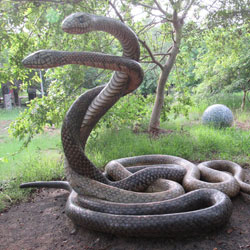
About Snake Park The Snake Park in Chennai is a popular tourist attraction that offers visitors the opportunity to see a wide variety of snake species up close. It is located in the Guindy National Park and is home to a diverse range of flora and fauna in addition to its resident snakes. The park plays a crucial role in educating the public about snakes and their importance in the ecosystem. Location and Geographical Overview The Snake Park is located in Guindy, which is a neighborhood in the southwestern part of Chennai, Tamil Nadu. It is situated within the Guindy National Park, which is one of the smallest national parks in India but boasts a rich biodiversity. The park is easily accessible by road and is a short drive from the city center. Open and Closing Time The Snake Park is open to visitors from 8:30 AM to 5:30 PM every day of the week, including weekends and public holidays. It is advisable to arrive early to make the most of your visit and avoid the crowds. Entry Fee The entry fee to the Snake Park is Rs. 20 for adults and Rs. 10 for children. Senior citizens and students with valid ID cards are eligible for a discounted rate of Rs. 10. Children under the age of 5 are allowed entry free of charge. Species-Flora/Fauna Availability In addition to a wide variety of snake species, the Snake Park is home to a diverse range of flora and fauna. Visitors can see different types of trees, plants, and animals indigenous to the region, making it a great destination for nature lovers. Activities Performed Visitors to the Snake Park can participate in a range of activities, including guided tours, snake shows, and educational demonstrations. The park also offers interactive exhibits and informative displays that teach visitors about the importance of snakes in the ecosystem. Jeep Safari Charges The Snake Park offers a thrilling jeep safari experience for visitors who want to explore the surrounding wilderness. The charges for a jeep safari vary depending on the duration and route chosen, with prices starting at Rs. 500 per person. Age Criterion and Entry Fee Visitors of all ages are welcome at the Snake Park. The entry fee for male and female visitors is Rs. 20, while children aged 5-12 are charged Rs. 10. Children under 5 are allowed free entry. Senior citizens aged 60 and above can enter at a discounted rate of Rs. 10. Senior Citizen Facilities The Snake Park is accessible for senior citizens and offers facilities such as seating areas, restrooms, and shaded spots for resting. Wheelchair access is available, and staff members are on hand to assist elderly visitors as needed. Best Time to Visit The best time to visit the Snake Park is during the cooler months of the year, from November to March. The weather is pleasant, and the snakes are more active during this time, making it an ideal time for viewing them in their natural habitat. Nearby Places to Visit There are several attractions near the Snake Park that visitors can explore, such as the Guindy National Park, Guindy Race Course, and the Madras War Cemetery. The historic Guindy Lodge and Raj Bhavan are also worth a visit. Vehicle Parking Facility The Snake Park offers ample parking space for visitors who arrive by car or motorcycle. The parking area is secure and monitored by staff members to ensure the safety of vehicles and belongings. Rules and Regulations Visitors to the Snake Park are required to follow certain rules and regulations to ensure the safety of themselves and the wildlife. Some of the rules include not feeding the animals, not littering, and not disturbing the snakes or other creatures in the park. How to Reach and Other Related Information The Snake Park is easily accessible by road from various parts of Chennai. Visitors can take a taxi, auto-rickshaw, or public bus to reach the park. The nearest railway station is Guindy, which is just a short distance away. It is advisable to plan your visit in advance and check for any updates or changes in the park's timings or regulations.
Explore More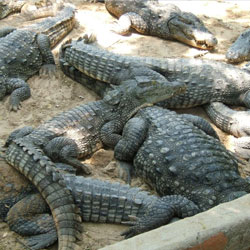
About Crocodile Bank The Madras Crocodile Bank Trust and Centre for Herpetology, commonly known as the Crocodile Bank, is a reptile zoo and research center located in Chennai, Tamil Nadu. It was established in 1976 by herpetologist Romulus Whitaker and is home to a large collection of reptiles, including crocodiles, alligators, snakes, and turtles. The Crocodile Bank is dedicated to conservation efforts and educating the public about these fascinating creatures. Location and Geographical Overview The Crocodile Bank is located in the town of Vadanemmeli, about 40 kilometers south of Chennai. Situated along the East Coast Road, the center is easily accessible by road. The lush green surroundings and proximity to the Bay of Bengal make it a picturesque location for visitors to enjoy. Open and Closing Time The Crocodile Bank is open to visitors from 8:30 am to 5:30 pm every day of the week, including weekends and holidays. It is advisable to arrive early to make the most of your visit and avoid the heat of the afternoon. Entry Fee The entry fee for adults is Rs. 50, while children under 10 years of age can enter for Rs. 30. Students with a valid ID card can avail of a discounted rate of Rs. 30. Foreign tourists are charged Rs. 200 for entry. Species-Flora/Fauna Availability The Crocodile Bank is home to a diverse range of reptiles, including crocodiles, alligators, snakes, and turtles. Visitors can learn about these fascinating creatures and their habitats through interactive exhibits and educational displays. The center also boasts a variety of native flora that adds to the natural beauty of the surroundings. Activities Performed Visitors to the Crocodile Bank can enjoy a range of activities, including guided tours, snake handling demonstrations, and feeding sessions for various reptiles. The center also offers educational programs for schools and groups, as well as research opportunities for students and scholars interested in herpetology. Jeep Safari Charges The Crocodile Bank offers a thrilling jeep safari through the surrounding forests and wetlands, allowing visitors to spot wildlife in their natural habitat. The safari charges vary depending on the duration and distance covered, with rates starting at Rs. 500 per person. Age Criterion and Entry Fee For males and females, the entry fee remains the same as mentioned earlier. Children under 10 years of age can enter for Rs. 30. Senior citizens are also charged Rs. 30 for entry to the Crocodile Bank. Senior Citizen Facilities Senior citizens visiting the Crocodile Bank can avail of special facilities, including designated seating areas, wheelchair access, and discounts on entry fees. The staff at the center are trained to assist elderly visitors and ensure their comfort during their visit. Best Time to Visit The best time to visit the Crocodile Bank is during the cooler months of the year, from November to February. The weather is more pleasant during this time, making it ideal for exploring the outdoor exhibits and enjoying the jeep safari. Avoid visiting during the peak summer months when temperatures can soar. Nearby Places to Visit Located along the scenic East Coast Road, the Crocodile Bank is close to several other attractions, including Mahabalipuram, a UNESCO World Heritage Site known for its ancient temples and rock carvings. Visitors can also explore the coastal town of Pondicherry, famous for its French colonial architecture and tranquil beaches. Vehicle Parking Facility The Crocodile Bank offers ample parking space for visitors arriving by car or motorcycle. The parking area is well-maintained and secure, providing peace of mind while you explore the center and its surroundings. Rules and Regulations While visiting the Crocodile Bank, visitors are expected to follow certain rules and regulations to ensure their safety and the well-being of the animals. This includes refraining from feeding or disturbing the animals, maintaining a safe distance from enclosures, and disposing of waste in designated bins. Smoking and littering are strictly prohibited on the premises. How to Reach and Other Related Information The Crocodile Bank is easily accessible by road from Chennai, with regular bus services and taxis available for transportation. For those driving to the center, follow the East Coast Road towards Mahabalipuram and look out for signposts indicating the entrance to the Crocodile Bank. The nearest railway station is at Chengalpattu, approximately 30 kilometers away, and the nearest airport is Chennai International Airport, about 45 kilometers from the center. Plan your visit to the Crocodile Bank and immerse yourself in the fascinating world of reptiles and conservation. Enjoy a day surrounded by nature and learn about these incredible creatures while supporting important conservation efforts.
Explore More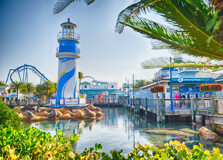
About SeaWorld Orlando SeaWorld Orlando is a popular marine theme park located in Orlando, Florida. It is known for its interactive experiences with marine animals, thrilling rides, and educational shows. The park is operated by SeaWorld Parks & Entertainment and offers a unique opportunity to learn about marine life and conservation efforts. Location and Geographical Overview SeaWorld Orlando is situated at 7007 Sea World Dr, Orlando, FL 32821, United States. It is conveniently located near the International Drive tourist district and is easily accessible from major highways in the area. Open and Closing Time SeaWorld Orlando typically opens at 10:00 AM and closes at 6:00 PM. However, the park hours may vary depending on the time of year and special events. Entry Fee The entry fee for SeaWorld Orlando varies depending on the age of the visitor and any special promotions or discounts that may be available. It is recommended to check the official website for current pricing information. Species-Flora/Fauna Availability SeaWorld Orlando is home to a wide variety of marine species, including dolphins, whales, sea lions, and penguins. The park also features a diverse collection of flora, including tropical plants and colorful flowers. Activities Performed Visitors to SeaWorld Orlando can enjoy a range of activities, including interactive exhibits, live shows, thrill rides, and behind-the-scenes tours. Some of the most popular attractions include the Shamu Stadium, Manta roller coaster, and Antarctica: Empire of the Penguin exhibit. Jeep Safari Charges SeaWorld Orlando does not offer a jeep safari experience. However, the park does offer other exciting animal encounters, such as dolphin swim programs and animal feeding experiences. Age Criterion and Entry Fee SeaWorld Orlando typically charges different entry fees based on the age of the visitor. Children under a certain age may be admitted for free, while adults and seniors may have to pay a regular admission fee. It is recommended to check the official website for current pricing information and age restrictions. Senior Citizen Facilities SeaWorld Orlando offers special facilities for senior citizens, including designated seating areas, handicap access, and discounted admission for guests over a certain age. Senior citizens can also enjoy special events and programs designed specifically for their enjoyment. Best Time to Visit The best time to visit SeaWorld Orlando is typically during the cooler months of the year, such as fall and winter. The park is less crowded during these times, allowing visitors to enjoy shorter wait times for attractions and shows. Nearby Places to Visit SeaWorld Orlando is located near other popular tourist destinations in Orlando, such as Walt Disney World and Universal Studios. Visitors can easily explore these nearby attractions and enjoy a full day of fun and excitement in the area. Vehicle Parking Facility SeaWorld Orlando offers a convenient vehicle parking facility for guests, with ample parking spaces available for cars, RVs, and buses. Parking fees may apply, so it is recommended to check the official website for current pricing information. Rules and Regulations Visitors to SeaWorld Orlando are expected to follow certain rules and regulations to ensure the safety and well-being of all guests and animals. Some common rules include no outside food or drinks, no smoking in designated areas, and no running or jumping in line. It is important to respect the park's guidelines and regulations at all times. How to Reach and Other Related Information SeaWorld Orlando is easily accessible by car, bus, or taxi from the Orlando area. The park is located just off Interstate 4 and is well-signposted from major highways. Visitors can also use rideshare services or public transportation to reach the park. For more information on how to reach SeaWorld Orlando and other related information, it is recommended to check the official website or contact the park directly.
Explore More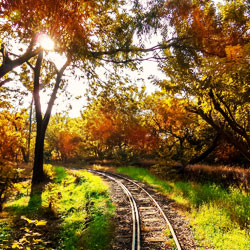
About Sanjay Gandhi National Park The Sanjay Gandhi National Park is a lush green paradise located in the northern part of Mumbai, India. Covering an area of 104 square kilometers, this national park is one of the most visited parks in the country and is a popular destination for nature lovers, adventure enthusiasts, and wildlife enthusiasts. The park is named after Sanjay Gandhi, the son of former Prime Minister of India, Indira Gandhi. Location and Geographical Overview The Sanjay Gandhi National Park is situated in the suburban district of Mumbai, covering areas of Borivali and Thane. The park is surrounded by hills and forests, providing a serene and peaceful environment for visitors to enjoy nature at its best. The park is home to a variety of flora and fauna, making it a biodiversity hotspot in the region. Open and Closing Time The Sanjay Gandhi National Park is open to visitors from 7:30 am to 6:30 pm every day of the week, including weekends and public holidays. The park closes at 6:30 pm, and visitors are not allowed to enter after this time. Entry Fee The entry fee for the Sanjay Gandhi National Park is INR 68 for adults and INR 38 for children. Senior citizens above the age of 65 can enter the park for free with a valid ID card. Foreign tourists have to pay INR 338 for entry. Species-Flora/Fauna Availability The Sanjay Gandhi National Park is home to a wide variety of flora and fauna. The park is famous for its rich biodiversity, with over 1,300 species of plants, 251 species of birds, 40 species of mammals, and 38 species of reptiles. Some of the animals found in the park include leopards, spotted deer, macaques, langurs, and Indian flying foxes. Activities Performed Visitors to the Sanjay Gandhi National Park can indulge in a range of activities such as nature walks, trekking, picnicking, bird watching, and cycling. The park also offers boating facilities at the Tulsi Lake and Vihar Lake, allowing visitors to enjoy a peaceful boat ride amidst the serene surroundings. Jeep Safari Charges The park also offers jeep safari rides for visitors who want to explore the park's wilderness and spot rare wildlife. The jeep safari charges are INR 800 per person for a 30-minute ride, allowing visitors to get up close and personal with the park's inhabitants. Age Criterion for Male, Female, Children and their Entry Fee The entry fee for the Sanjay Gandhi National Park is INR 68 for male adults, female adults, and children above the age of 5. Children below the age of 5 can enter the park for free. Senior citizens above the age of 65 can enter the park for free with a valid ID card. Senior Citizen Facilities Senior citizens above the age of 65 are entitled to free entry to the Sanjay Gandhi National Park with a valid ID card. The park provides special facilities for senior citizens, including wheelchair accessibility, resting areas, and designated walking trails for a comfortable and enjoyable visit. Best Time to Visit The best time to visit the Sanjay Gandhi National Park is during the winter months of November to February when the weather is pleasant and cool. The park is lush and green during this time, making it ideal for outdoor activities and wildlife spotting. Nearby Places to Visit There are several attractions near the Sanjay Gandhi National Park that visitors can explore, including the Kanheri Caves, a group of ancient Buddhist rock-cut caves dating back to the 1st century BC. Other nearby attractions include the Global Vipassana Pagoda, Film City, and Yeoor Hills. Vehicle Parking Facility The Sanjay Gandhi National Park provides ample parking facilities for visitors, with designated parking areas available near the park's entrance. Visitors can park their cars or bikes securely and conveniently while they explore the park's attractions and activities. Rules and Regulations Visitors to the Sanjay Gandhi National Park are required to follow certain rules and regulations to ensure the safety of wildlife and maintain the park's ecological balance. Some of the rules include not feeding the animals, not littering, not making loud noises, and not plucking flowers or plants. How to Reach and Other Related Information The Sanjay Gandhi National Park is easily accessible by road and public transport. Visitors can take a taxi, bus, or auto-rickshaw to reach the park from various parts of Mumbai. The nearest railway station to the park is Borivali, which is well-connected to other parts of the city. The park also has facilities like restrooms, food stalls, and information centers to cater to the needs of visitors. Overall, the Sanjay Gandhi National Park is a must-visit destination for nature lovers, wildlife enthusiasts, and adventure seekers looking to experience the beauty of Mumbai's natural landscape. With its diverse flora and fauna, exciting activities, and serene surroundings, the park offers a unique and memorable experience for visitors of all ages.
Explore More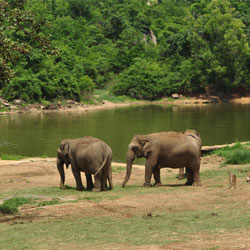
About Bannerghatta National Park Located in Bangalore, Karnataka, the Bannerghatta National Park is a popular destination for nature lovers and wildlife enthusiasts. Spread over 104.27 square kilometers, the park is home to a variety of flora and fauna, making it a must-visit for anyone looking to experience the beauty of nature up close. Location and Geographical Overview The Bannerghatta National Park is situated approximately 22 kilometers south of Bangalore city. It is nestled in the picturesque surroundings of the Champakadhama Hills, providing a serene and peaceful environment for visitors to explore. The park is divided into several sections, including a zoo, a butterfly park, a safari area, and a rescue center. Opening and Closing Time The park is open to visitors from 9:00 AM to 5:00 PM on all days of the week, except for Tuesdays when it remains closed for maintenance. Entry Fee The entry fee for the Bannerghatta National Park varies based on the activities you choose to engage in. The basic entry fee for adults is INR 80, while children have a discounted rate of INR 40. Additional charges apply for activities such as safaris and the butterfly park. Species - Flora/Fauna Availability The park is home to a diverse range of flora and fauna, including various species of plants, trees, birds, mammals, and reptiles. Visitors can spot animals such as tigers, lions, elephants, bears, deer, and more in their natural habitat within the park. Activities Performed Visitors to the Bannerghatta National Park can engage in a variety of activities, including wildlife safaris, nature walks, bird watching, butterfly park visits, and more. The park offers a range of experiences for visitors of all ages and interests. Jeep Safari Charges The jeep safari at the park is a popular attraction that allows visitors to explore the wilderness and spot animals in their natural habitat. The charges for the jeep safari vary based on the type of safari chosen, with rates starting from INR 250 per person. Age Criterion and Entry Fee The entry fee for the park is determined based on the age of the visitor. Adult visitors are required to pay INR 80, while children between the ages of 6-12 are charged INR 40. Children under the age of 6 are granted free entry to the park. Senior Citizen Facilities The Bannerghatta National Park offers special facilities for senior citizens, including discounted entry rates, wheelchair accessibility, and designated resting areas for them to relax and enjoy the beauty of the park. Best Time to Visit The best time to visit the Bannerghatta National Park is during the winter months, from November to February, when the weather is pleasant and ideal for outdoor activities. Avoid visiting during the monsoon season, as heavy rainfall can disrupt your experience. Nearby Places to Visit While in the vicinity of the Bannerghatta National Park, visitors can explore other attractions such as the Bannerghatta Biological Park, the Butterfly Park, the Suvarna Mukhi Pond, and the Champakadhama Swamy Temple for a complete day of sightseeing and adventure. Vehicle Parking Facility The park provides ample parking space for visitors who arrive in their vehicles. The parking facility is safe and secure, ensuring that your vehicle remains protected while you explore the park and its various attractions. Rules and Regulations Visitors to the Bannerghatta National Park are required to follow certain rules and regulations to ensure the safety of the wildlife and maintain the cleanliness of the park. It is prohibited to feed the animals, litter the park, make loud noises, or disturb the natural habitat in any way. How to Reach and Other Related Information The Bannerghatta National Park is easily accessible by road from Bangalore city, with regular bus services and taxis available to transport visitors to the park. It is approximately a one-hour drive from the city center, making it a convenient day trip destination for tourists and locals alike. Overall, the Bannerghatta National Park offers a unique and immersive experience for nature lovers, wildlife enthusiasts, and families looking to connect with the beauty of the natural world. With its diverse range of flora and fauna, exciting activities, and serene surroundings, the park is a must-visit destination for anyone seeking a memorable and enriching outdoor adventure.
Explore More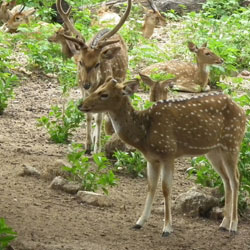
About Deer Park The Deer Park in Hyderabad is a popular tourist destination located in the heart of the city. It is a sprawling green oasis that is home to a variety of flora and fauna, including graceful deer that roam freely within the park. The park offers a serene and peaceful environment, making it a perfect place to unwind and connect with nature. Location and Geographical Overview The Deer Park is located in the heart of Hyderabad, near HITEC City. It covers an area of around 80 acres and is surrounded by lush greenery, making it a beautiful and tranquil spot for visitors to enjoy. Open and Closing Time The Deer Park is open to visitors from 8:00 AM to 6:00 PM every day of the week. Entry Free There is no entry fee to visit the Deer Park, making it accessible to all visitors. Species-Flora/Fauna Availability The park is home to a variety of flora and fauna, including various species of deer, peacocks, and other birds. Visitors can also spot different types of trees, plants, and flowers within the park. Activities Performed Visitors to the Deer Park can enjoy activities such as walking, bird-watching, and photography. The park also offers a serene environment for meditation and relaxation. Jeep Safari Charges The Deer Park does not offer jeep safari rides at the moment. Age Criterion for Male, Female, Children and Their Entry Fee There is no specific age criterion for entry to the Deer Park, and visitors of all ages are welcome. The entry fee is also free for all visitors. Senior Citizen Facilities The Deer Park provides facilities for senior citizens, including benches and shaded areas where they can rest and relax while enjoying the natural surroundings. Best Time to Visit The best time to visit the Deer Park is during the early morning or late afternoon when the weather is cooler and the wildlife is more active. Nearby Places to Visit Some nearby places to visit include Shilparamam Cultural Society, Durgam Cheruvu, and Botanical Gardens, which are all within a short driving distance from the Deer Park. Vehicle Parking Facility The Deer Park offers ample parking space for visitors who wish to drive to the park. The parking facility is safe and secure, allowing visitors to enjoy their visit without any concerns. Rules and Regulations Visitors to the Deer Park are required to follow certain rules and regulations to ensure the safety of the wildlife and other visitors. Some of the rules include not feeding the animals, maintaining cleanliness, and not causing any disturbance to the natural environment. How to Reach and Other Related Information The Deer Park is easily accessible by road, and visitors can reach the park by car, taxi, or public transportation. It is located near HITEC City, making it a convenient destination for both locals and tourists. The park is well-maintained and offers a peaceful retreat for those looking to escape the hustle and bustle of the city.
Explore More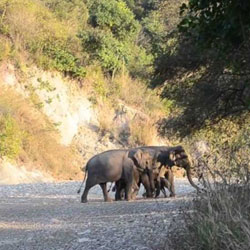
About Rajaji National Park Rajaji National Park, located near Dehradun in the state of Uttarakhand, is a magnificent wildlife sanctuary that spans across three districts - Haridwar, Dehradun, and Pauri Garhwal. It was established in 1983 and covers an area of 820 square kilometers, making it one of the largest national parks in India. The park is named after C. Rajagopalachari, a prominent leader of the Indian independence movement. Location and Geographical Overview Rajaji National Park is situated at the foothills of the Shivalik range in the Himalayas. The park is known for its diverse terrain, which includes dense forests, grasslands, and riverine vegetation. The park is home to a variety of wildlife species, including elephants, tigers, leopards, deer, and over 400 species of birds. Open and Closing Time The park is open to visitors from 6:00 AM to 9:00 PM every day of the week. Entry Fee The entry fee for Indian nationals is Rs. 150 per person, while foreign nationals are charged Rs. 600 per person. Children below the age of 5 years can enter for free. Species-Flora/Fauna Availability Rajaji National Park is home to a diverse range of flora and fauna. The park is known for its rich biodiversity, with over 300 species of birds, 50 species of mammals, and numerous reptiles and amphibians. Some of the wildlife species that can be spotted in the park include elephants, tigers, leopards, deer, monkeys, and bears. Activities Performed Visitors to Rajaji National Park can indulge in a variety of activities, including jeep safaris, elephant safaris, bird watching, nature walks, and wildlife photography. The park also offers opportunities for camping and trekking. Jeep Safari Charges The cost of a jeep safari in Rajaji National Park is Rs. 1500 per jeep for Indian nationals and Rs. 4000 per jeep for foreign nationals. The safari lasts for approximately 3-4 hours and covers various parts of the park where you can spot wildlife in their natural habitats. Age Criterion and Entry Fee for Male, Female, and Children The entry fee for Indian nationals is Rs. 150 per person for adults and children above the age of 5 years. Children below the age of 5 can enter for free. There is no separate entry fee based on gender. Senior Citizen Facilities Senior citizens above the age of 60 years can avail a discount on the entry fee by showing valid identification. They can also opt for a comfortable safari vehicle with seating arrangements that are suitable for their needs. Best Time to Visit The best time to visit Rajaji National Park is from November to March when the weather is pleasant and wildlife sightings are more common. Avoid visiting during the monsoon season (July-September) as the park may be closed due to heavy rainfall and slippery roads. Nearby Places to Visit There are several tourist attractions near Rajaji National Park that you can visit, including Robber's Cave, Buddha Temple, Sahastradhara, and the famous hill station of Mussoorie. Vehicle Parking Facility Rajaji National Park provides ample parking space for private vehicles near the entry gates. Visitors can safely park their cars and continue their exploration of the park in safari vehicles provided by the park authorities. Rules and Regulations Visitors to Rajaji National Park are required to follow certain rules and regulations to ensure the safety of wildlife and maintain the sanctity of the park. Some of the rules include maintaining silence during safaris, not feeding the animals, and not littering the park premises. How to Reach and Other Related Information Rajaji National Park is well-connected by road and can be easily reached from major cities like Dehradun and Haridwar. The nearest airport is the Jolly Grant Airport in Dehradun, which is approximately 20 kilometers away from the park. The nearest railway station is in Haridwar, which is around 30 kilometers from the park. Visitors can also opt for guided tours and packages offered by various tour operators in the region for a hassle-free visit to the park. It is advisable to book safari tickets in advance to avoid any last-minute rush. Plan your visit to Rajaji National Park to experience the beauty of nature and witness the majestic wildlife that thrives in this lush sanctuary.
Explore More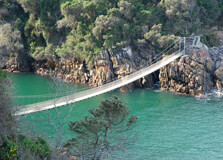
The Garden Route National Park is a picturesque paradise located on the southern coast of South Africa. It is a combination of three distinct sections – the Tsitsikamma, Wilderness, and Knysna national parks. The park covers a vast area of lush forests, pristine beaches, and dramatic coastlines, making it a popular destination for nature lovers and outdoor enthusiasts. Location and Geographical Overview The Garden Route National Park stretches along the Garden Route, a scenic stretch of coastline that runs from Mossel Bay in the west to Storms River in the east. The park is situated in the Western Cape province of South Africa, approximately a 5-hour drive from Cape Town. Opening and Closing Time The Garden Route National Park is open to visitors all year round. The gates typically open at 7 am and close at 6 pm. Entry Fee Entry fees to the Garden Route National Park vary depending on the section you are visiting and the activities you plan to do. The fees range from R40 to R200 for adults, with discounted rates for children and senior citizens. Species-Flora/Fauna Availability The Garden Route National Park is home to a diverse range of plant and animal species. The park is famous for its ancient forests, including giant yellowwoods and Outeniqua yellowwoods. Wildlife enthusiasts can also spot a variety of animals, such as elephants, buffaloes, leopards, and various bird species. Activities Performed Visitors to the Garden Route National Park can enjoy a wide range of activities, including hiking, birdwatching, picnicking, swimming, and camping. The park also offers guided walks, boat cruises, and jeep safaris for a more immersive experience. Jeep Safari Charges Jeep safari charges in the Garden Route National Park vary depending on the duration and route of the safari. Prices typically range from R500 to R1500 per person. Age Criterion and Entry Fee Entry fees for the Garden Route National Park are based on age categories. Children under the age of 12 usually enjoy discounted rates, while senior citizens may also be eligible for reduced fees. Adult entry fees apply to individuals over the age of 18. Senior Citizen Facilities The Garden Route National Park offers facilities and services tailored to the needs of senior citizens, including wheelchair-accessible paths, rest areas, and discounted rates for entry fees and activities. Best Time to Visit The best time to visit the Garden Route National Park is during the spring and autumn months (September to November and March to May), when the weather is mild, and the landscapes are lush and vibrant. However, the park is open year-round and offers unique experiences in every season. Nearby Places to Visit While exploring the Garden Route National Park, visitors can also visit nearby attractions such as the Tsitsikamma National Park, Wilderness National Park, and Knysna Lagoon. The charming towns of Knysna, Plettenberg Bay, and George are also worth a visit. Vehicle Parking Facility The Garden Route National Park provides parking facilities at designated areas near the entrance gates and popular attractions. Visitors are advised to follow the park's regulations and guidelines when parking their vehicles. Rules and Regulations Visitors to the Garden Route National Park are required to abide by certain rules and regulations to ensure the safety of themselves, other visitors, and the park's ecosystem. Some common regulations include staying on designated trails, refraining from littering, and respecting wildlife habitats. How to Reach and Other Related Information The Garden Route National Park is easily accessible by car from major cities in South Africa. Visitors can also reach the park by bus or organized tours. For more information on directions, accommodations, and activities, visitors can contact the park's visitor center or visit the official website.
Explore More
About Dachigam National Park Dachigam National Park is a stunning wildlife sanctuary located in the state of Jammu and Kashmir in India. The name "Dachigam" translates to "ten villages," referencing the ten villages that were relocated to create the park in 1910. The park covers an area of approximately 141 square kilometers and is nestled in the beautiful Dachigam Valley, surrounded by the mighty Himalayas. Location and Geographical Overview Dachigam National Park is situated at a distance of about 22 kilometers from Srinagar, the summer capital of Jammu and Kashmir. The park is spread across the elevated slopes of the Zabarwan Mountain Range and is home to a diverse range of flora and fauna. Opening and Closing Time The park is open to visitors from 6:00 am to 5:00 pm on all days of the week, except for Fridays. Entry Fee The entry fee for Indian visitors is Rs. 50 per person, while foreign tourists are charged Rs. 300 per person. Children below the age of 5 years can enter the park for free. Species-Flora/Fauna Availability Dachigam National Park is renowned for its rich biodiversity. The park is home to a variety of flora, including coniferous forests, alpine pastures, and meadows. As for fauna, the park is known for its population of the endangered Hangul (Kashmir Stag), leopards, musk deer, Himalayan black bear, and various bird species. Activities Performed Visitors to Dachigam National Park can enjoy various activities such as wildlife viewing, bird watching, nature walks, and trekking. The park offers a tranquil environment for nature enthusiasts to explore and appreciate the beauty of the Himalayan ecosystem. Jeep Safari Charges Jeep safaris are available for visitors to explore the park and spot wildlife in their natural habitat. The charges for a jeep safari in Dachigam National Park may vary, and it is advisable to inquire at the park entrance or visitor center for current rates. Age Criterion and Entry Fee For male and female visitors, there is no specific age criterion for entry into the park. Children below the age of 5 years can enter for free, while those above 5 years are required to pay the applicable entry fee. Senior Citizen Facilities Dachigam National Park welcomes senior citizens to visit and explore the park. Special arrangements such as seating areas, resting points, and accessible pathways are provided to ensure a comfortable experience for senior visitors. Best Time to Visit The best time to visit Dachigam National Park is during the summer months from May to August, when the weather is pleasant, and wildlife sightings are more common. The park is typically closed during the winter months due to heavy snowfall. Nearby Places to Visit While visiting Dachigam National Park, visitors can also explore other popular destinations in the region such as Mughal Gardens, Dal Lake, Shankaracharya Temple, and Pari Mahal. These attractions offer a glimpse into the rich cultural and historical heritage of Kashmir. Vehicle Parking Facility Ample parking facilities are available near the entrance of Dachigam National Park for visitors who prefer to drive to the park. Visitors are advised to follow parking regulations and avoid blocking access points to ensure a smooth flow of traffic. Rules and Regulations Visitors to Dachigam National Park are required to adhere to certain rules and regulations to ensure the preservation of the park's ecosystem. Some common guidelines include not littering, refraining from feeding wildlife, and following designated pathways to avoid disturbing the natural habitat. How to Reach and Other Related Information Dachigam National Park is easily accessible from Srinagar by road, and taxis or private vehicles can be hired to reach the park entrance. The nearest airport is Srinagar International Airport, located approximately 28 kilometers away. For accommodations, visitors can choose from a range of hotels and guesthouses in Srinagar city. Overall, Dachigam National Park offers a unique opportunity to witness the natural beauty and wildlife of the Himalayan region. Whether you are a nature lover, wildlife enthusiast, or simply seeking a peaceful retreat, a visit to this spectacular park is sure to leave you spellbound.
Explore More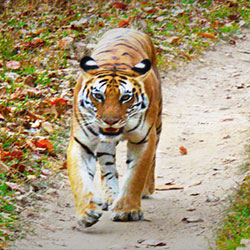
About Kanha National Park Kanha National Park is a renowned wildlife sanctuary located in the Mandla district of Madhya Pradesh, India. It is one of the largest national parks in India, covering an area of 940 square kilometers. Established in 1955, the park is famous for its diverse range of flora and fauna, including the majestic Royal Bengal Tiger. The lush green forests, meadows, and streams make it a haven for nature lovers and wildlife enthusiasts. Location and Geographical Overview Kanha National Park is situated in the Maikal Hills of the Satpura Range. It is located near the towns of Mandla and Balaghat in the state of Madhya Pradesh. The park is characterized by its dense forests, grasslands, and numerous watering holes, providing a conducive habitat for a wide variety of wildlife. Opening and Closing Time The park is open for visitors from October to June every year. The timings are from 6:30 am to 10:30 am for the morning safari and from 2:30 pm to 6:00 pm for the evening safari. Entry Fee The entry fee for Indian nationals is INR 1530 per person for a safari. Foreign nationals are charged INR 3060 per person. Additional charges apply for cameras and vehicles. Species-Flora/Fauna Availability Kanha National Park is home to a diverse range of flora and fauna. Some of the species found here include tigers, leopards, wild dogs, swamp deer, barasingha, jackals, hyenas, and more. The park is also known for its rich vegetation, including sal forests, bamboo groves, and grasslands. Activities Performed Visitors to Kanha National Park can enjoy a variety of activities such as jeep safaris, nature walks, birdwatching, and photography. The park also offers guided tours and wildlife presentations for a more immersive experience. Jeep Safari Charges The cost of a jeep safari in Kanha National Park varies depending on the zone and duration of the safari. On average, the prices range from INR 2000 to INR 5000 per person. Age Criterion for Male, Female, Children, and Entry Fee Children below the age of 5 years are not allowed entry into the park. The entry fee for children between 5-12 years is INR 1530. For adults (male and female), the entry fee is INR 3060. Senior Citizen Facilities Kanha National Park offers special facilities for senior citizens, including wheelchair access, designated rest areas, and priority seating on safari vehicles. Discounted rates may also be available for senior citizens. Best Time to Visit The best time to visit Kanha National Park is during the winter months from November to February. The weather is pleasant, and wildlife sightings are more frequent during this time. The park is closed during the monsoon season from July to September. Nearby Places to Visit Some of the nearby attractions to Kanha National Park include the Bamni Dadar viewpoint, Sonf Meadows, and Kawardha Palace. These places offer scenic beauty, cultural insights, and opportunities for relaxation and exploration. Vehicle Parking Facility Kanha National Park provides designated parking areas for private vehicles near the entrance gate. Visitors can safely park their cars and proceed to the safari vehicles provided by the park authorities. Rules and Regulations Visitors to Kanha National Park are required to follow certain rules and regulations to ensure the safety of wildlife and maintain the ecological balance. Some of the common rules include maintaining silence during safaris, refraining from feeding or disturbing animals, and adhering to designated safari routes. How to Reach and Other Related Information Kanha National Park is well-connected by road, rail, and air. The nearest airport is Jabalpur Airport, approximately 160 kilometers away. The nearest railway station is Bilaspur Junction, around 150 kilometers from the park. Visitors can also opt for private or public transport to reach the park from nearby towns and cities. It is advisable to make advance bookings for safari permits and accommodations to avoid any last-minute hassles. Additionally, carrying essential items such as water bottles, hats, sunscreen, and binoculars can enhance your wildlife viewing experience at Kanha National Park.
Explore More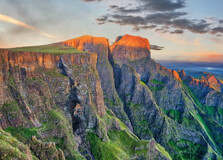
Ukhahlamba Drakensberg Park, located in KwaZulu-Natal, South Africa, is a UNESCO World Heritage Site known for its breathtaking natural beauty and immense cultural significance. Covering over 240,000 hectares, the park is part of the majestic Drakensberg Mountain Range, the highest in Southern Africa. It is renowned for its dramatic peaks, rich biodiversity, crystal-clear streams, waterfalls, and the largest collection of rock art in Africa, created by the San people over a period of 4,000 years. How to Reach Ukhahlamba Drakensberg Park, KwaZulu-Natal The park is accessible by road from major cities in KwaZulu-Natal and the surrounding provinces: By Car from Durban: The park is approximately 250 km (3-4 hours' drive) northwest of Durban. Take the N3 highway towards Pietermaritzburg and follow signs toward towns like Winterton, Underberg, or Bergville, depending on which section of the park you're visiting. By Car from Johannesburg: It's about 400-500 km (5-6 hours) south of Johannesburg, depending on the entry point. By Air: The nearest major airport is King Shaka International Airport in Durban. From there, you can rent a car to drive to the park. By Bus/Tour: Several tour operators offer group trips or private tours to the park with accommodation and activities included. Weather at Ukhahlamba Drakensberg Park The park has a temperate mountain climate: Summer (November to March): Warm and rainy with daytime temperatures between 20°C and 30°C. Thunderstorms are common in the afternoons. Winter (May to August): Cold and dry, with daytime highs around 15°C and freezing temperatures at night. Snow may fall on higher peaks. The best time to visit is during the dry months from May to September for hiking and rock art viewing. Spring (September to October) offers blooming wildflowers and moderate weather. Timings to Visit The park is open year-round. Most access gates are open daily from 6:00 AM to 6:00 PM. Specific opening hours may vary slightly by region (e.g., Royal Natal, Cathedral Peak, Giant's Castle). It is advisable to arrive early in the day for hikes and outdoor activities, especially in summer when afternoon storms can develop quickly. Why Famous for Ukhahlamba Drakensberg Park, KwaZulu-Natal? The park is famous for: San Rock Art: Home to over 600 rock art sites and 35,000 individual paintings, making it the largest and most concentrated group of rock paintings in Africa south of the Sahara. Spectacular Scenery: Towering basalt cliffs, lush valleys, waterfalls, and rolling foothills create an awe-inspiring natural landscape. World Heritage Status: Recognized by UNESCO for both natural and cultural value. Biodiversity: A hotspot for endemic species of plants, birds, and mammals. Entry and Visit Details Entry fees vary depending on the section of the park: Adults: Approx. R65 – R90 per person Children: Approx. R35 – R50 per child The park is divided into multiple areas with separate entrances, including Giant’s Castle, Royal Natal, Cathedral Peak, and Kamberg. Each has its own visitor centre, hiking trails, and facilities. Camping sites, chalets, and lodges are available for overnight stays, often with advance booking required. History and Architecture Ukhahlamba means "Barrier of Spears" in Zulu, reflecting the rugged and imposing nature of the mountain range. The San people inhabited the area for thousands of years, leaving behind a priceless legacy of rock paintings that depict daily life, animals, and spiritual beliefs. Though the park does not have classical architectural structures, it is rich in ancient cultural expressions carved and painted onto the rock faces of caves and overhangs. Rangers and cultural guides help interpret this heritage during guided tours. Things to Do at Ukhahlamba Drakensberg Park Hiking: Trails range from easy walks to challenging multi-day treks. Popular routes include the Amphitheatre hike in Royal Natal and the climb to the Tugela Falls. Rock Art Tours: Visit San rock painting sites with expert guides, particularly at Kamberg and Giant’s Castle. Bird Watching: Spot the endangered bearded vulture and many endemic species. Horse Riding: Several lodges offer horseback trails through the foothills. Photography: The park is a photographer’s paradise with dramatic landscapes, sunrises, and wildlife. Camping and Star Gazing: Camp under clear skies and enjoy one of the best natural observatories in the region. Facts about Ukhahlamba Drakensberg Park The park spans over 240,000 hectares and links to the Maloti Mountains in Lesotho, forming the transfrontier Maloti-Drakensberg Park. Tugela Falls, one of the tallest waterfalls in the world (948 meters), is located in the Royal Natal section. The San rock art dates back thousands of years and is well preserved due to the dry mountain climate. Home to more than 2,500 plant species, including many endemic to the region. Declared a World Heritage Site in 2000 for its natural beauty and cultural significance. Tips about Ukhahlamba Drakensberg Park, KwaZulu-Natal Wear layered clothing as temperatures can vary greatly throughout the day. Always carry water, sunscreen, a map, and weatherproof gear when hiking. Book guided rock art tours for in-depth understanding of San culture. Some trails and campsites require permits—check in advance. Travel in groups or inform someone of your hiking route and return time. Cell phone signal may be limited in some remote areas—carry a GPS or compass. Respect wildlife and do not disturb or damage any rock art or natural features.
Explore More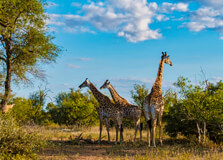
Kruger National Park, located in the Limpopo province of South Africa, is one of the largest game reserves in Africa. Covering an area of nearly 20,000 square kilometers, the park is home to a wide variety of wildlife, including the famous Big Five - lions, leopards, elephants, rhinos, and buffaloes. The park was established in 1926 and named after Paul Kruger, a former president of the South African Republic. Location and Geographical Overview Kruger National Park is situated in northeastern South Africa, bordering Zimbabwe and Mozambique. The park encompasses diverse landscapes, including open savannah, dense forests, and rolling hills. The Crocodile River runs along the southern boundary of the park, providing water for the wildlife that inhabits it. Open and Closing Time The park is open to visitors from sunrise to sunset, with specific entrance gates having varying opening and closing times. It is important to check the official website for the most up-to-date information on operating hours. Entry Fee There is an entrance fee for visitors to Kruger National Park, with rates varying for South African residents, SADC (Southern African Development Community) nationals, and international tourists. It is recommended to purchase entry permits in advance to avoid delays at the gates. Species-Flora/Fauna Availability Kruger National Park is renowned for its rich biodiversity, with over 500 bird species, 147 mammal species, and countless plant varieties. Visitors have the opportunity to spot a wide array of wildlife, from rare birds to large predators, making it a paradise for nature lovers and wildlife enthusiasts. Activities Performed There are numerous activities to enjoy within the park, including game drives, guided walks, birdwatching, and wilderness trails. Visitors can also visit cultural heritage sites and attend educational programs to learn more about the park's conservation efforts. Jeep Safari Charges Jeep safaris are a popular way to explore Kruger National Park, allowing visitors to get up close to wildlife in their natural habitat. The park offers guided safari tours, with prices varying depending on the duration and type of safari chosen. Age Criterion and Entry Fee Entry fees for Kruger National Park are typically based on age and nationality. Children under a certain age may enter for free, while discounted rates are often available for senior citizens. It is advisable to check the official website for the most current pricing information. Senior Citizen Facilities Kruger National Park offers facilities and services tailored to the needs of senior citizens, including accessible accommodation, transportation, and guided tours. Special discounts may also be available for older visitors, making it easier for them to enjoy their visit to the park. Best Time to Visit The best time to visit Kruger National Park is during the dry season, from May to September, when vegetation is sparse, and wildlife congregates around water sources. This period offers optimal game viewing opportunities and comfortable weather conditions for outdoor activities. Nearby Places to Visit There are several nearby attractions to explore while visiting Kruger National Park, including Blyde River Canyon, Bourke's Luck Potholes, and the Panorama Route. These natural wonders offer stunning views and unique geological formations that are worth seeing during your trip. Vehicle Parking Facility Kruger National Park provides designated parking areas at its entrance gates, rest camps, and popular attractions within the park. Visitors are advised to lock their vehicles and refrain from leaving any valuable items inside to prevent theft or damage. Rules and Regulations Visitors to Kruger National Park are required to adhere to strict rules and regulations to ensure the safety of wildlife and maintain the park's pristine environment. This includes staying on designated roads, refraining from feeding animals, and respecting the natural habitat of the wildlife. How to Reach and Other Related Information Kruger National Park can be accessed by road, air, or organized tours from major cities in South Africa. The closest airports are in Nelspruit and Hoedspruit, with options for shuttle services to the park. It is recommended to plan your visit in advance and book accommodations within the park or nearby lodges for a seamless experience. With its diverse landscapes, abundant wildlife, and conservation efforts, Kruger National Park offers a memorable safari experience for visitors of all ages. Whether you are a nature enthusiast, adventure seeker, or simply looking to immerse yourself in the beauty of the African bush, a trip to this iconic park is sure to leave you in awe of the natural world.
Explore More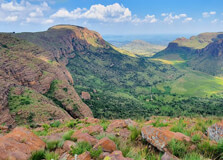
Located in Limpopo, South Africa, Marakele National Park is a breathtaking natural sanctuary that offers visitors the chance to experience the beauty of the African wilderness up close. The name "Marakele" means 'a place of sanctuary' in Tswana, and this park truly lives up to its name, providing a safe haven for a wide variety of wildlife. Location and Geographical Overview Marakele National Park covers an area of approximately 67,000 hectares and is situated in the Waterberg region of Limpopo. The park is characterized by dramatic landscapes, including towering mountains, lush valleys, and winding rivers. The diverse terrain creates a variety of habitats that support a rich array of plant and animal species. Open and Closing Time The park is open to visitors from 6:00 am to 6:00 pm daily. Entry Fee The entry fee for Marakele National Park is R100 for adults and R50 for children under 12 years old. South African citizens and residents enjoy a discounted rate of R40 for adults and R20 for children. Species-Flora/Fauna Availability Marakele National Park is home to a diverse range of flora and fauna. Visitors can expect to see iconic African wildlife such as elephants, lions, rhinos, and giraffes, as well as a variety of bird species. The park also boasts a number of unique plant species, including the rare cycads that dot the landscape. Activities Performed Visitors to Marakele National Park can enjoy a range of activities, including guided game drives, hiking trails, and birdwatching. The park also offers camping facilities for those who wish to spend the night in the wilderness. Jeep Safari Charges Jeep safari charges vary depending on the duration of the safari and the number of participants. Prices typically range from R300 to R1000 per person. Age Criterion for Male, Female, Children and their Entry Fee Adult entry fees apply to individuals aged 12 and above. Children under 12 years old receive a discounted rate. There is no specific age criterion for male or female visitors. Senior Citizen Facilities Senior citizens may be eligible for discounted entry fees, depending on their age and residency status. The park also offers facilities such as wheelchair access and designated rest areas for elderly visitors. Best Time to Visit The best time to visit Marakele National Park is during the dry season, from May to September, when wildlife congregates around water sources, making for excellent game viewing opportunities. Nearby Places to Visit Visitors to Marakele National Park can explore the surrounding area and visit attractions such as the picturesque town of Thabazimbi, the Marakele Predator Centre, and the Waterberg Biosphere Reserve. Vehicle Parking Facility The park offers designated parking areas for visitors, with ample space for both cars and buses. Overnight guests can park their vehicles at the designated camping sites. Rules and Regulations Visitors to Marakele National Park are required to adhere to a set of rules and regulations to ensure the safety of both wildlife and fellow visitors. Some of the key rules include staying on designated roads and trails, refraining from feeding or approaching wildlife, and properly disposing of waste. How to Reach and Other Related Information Marakele National Park is easily accessible by road from major cities such as Johannesburg and Pretoria. The park is located approximately 250 km from Johannesburg and can be reached via the N1 highway. Visitors can also fly into nearby airports such as Tambo International Airport in Johannesburg and arrange for transportation to the park. For more information on visiting Marakele National Park, including accommodation options, guided tours, and special events, visitors are encouraged to contact the park's visitor center or visit the official park website.
Explore More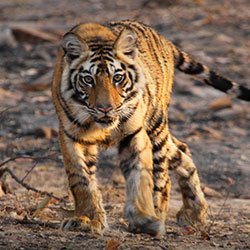
About Bandhavgarh National Park Bandhavgarh National Park, located in Umaria district of Madhya Pradesh, is one of the most popular national parks in India. It covers an area of 105 square kilometers and is known for its dense forest, hilly terrain, and rich biodiversity. The park is famous for its high population of Royal Bengal tigers and is a popular destination for wildlife enthusiasts and nature lovers. Location and Geographical Overview Bandhavgarh National Park is located in the Vindhya Hills of Madhya Pradesh, India. It is approximately 197 kilometers away from the city of Jabalpur and 35 kilometers from the town of Umaria. The park is spread across the tropical forests and grasslands of the region, with streams, rocky hills, and meadows making up its diverse landscape. Open and Closing Time The park remains open from October to June every year. The opening and closing timings of the park vary depending on the season. Generally, the park is open for visitors from 6:30 AM to 10:00 AM in the morning and from 3:00 PM to 6:00 PM in the evening. Entry Fee The entry fee for Bandhavgarh National Park varies for Indian and foreign nationals. For Indian visitors, the entry fee is INR 1500 per person, while for foreign nationals, the fee is INR 2500 per person. Additionally, there may be charges for vehicle entry and camera fees. Species-Flora/Fauna Availability Bandhavgarh National Park is home to a wide variety of flora and fauna. The park is known for its dense vegetation, including Sal trees, bamboo, and grasslands. The park is also home to numerous animal species, including the Royal Bengal tiger, Indian bison, leopard, sambar deer, and various species of birds and reptiles. Activities Performed Visitors to Bandhavgarh National Park can indulge in a range of activities, including jeep safaris, elephant safaris, bird watching, and nature walks. The park is ideal for wildlife photography and offers opportunities to witness the diverse wildlife in their natural habitat. Jeep Safari Charges The charges for jeep safari in Bandhavgarh National Park vary depending on the zone and the duration of the safari. On average, the cost of a jeep safari ranges from INR 4000 to INR 6000 per safari. It is advisable to book safari tickets in advance to avoid any last-minute hassles. Age Criterion and Entry Fee For entry into Bandhavgarh National Park, the age criteria and entry fees are as follows: Male Adults: 18-60 years, Entry Fee - INR 1500 Female Adults: 18-60 years, Entry Fee - INR 1500 Children (6-17 years): Entry Fee - INR 750 Senior Citizen Facilities Bandhavgarh National Park provides special facilities for senior citizens, including discounted entry fees, wheelchair access, and assistance from park staff. Senior citizens above the age of 60 can avail of these facilities by presenting valid identification documents. Best Time to Visit The best time to visit Bandhavgarh National Park is during the winter months from November to February when the weather is pleasant and the wildlife sightings are more frequent. However, the park remains open from October to June, allowing visitors to explore its beauty throughout the year. Nearby Places to Visit There are several places of interest near Bandhavgarh National Park that visitors can explore, including: Bandhavgarh Fort: An ancient fort located within the park premises Manpur Village: A nearby village known for its local culture and traditions Khajuraho Temples: A UNESCO World Heritage Site known for its intricate sculptures Vehicle Parking Facility Bandhavgarh National Park provides ample parking facilities for visitors who wish to bring their vehicles. There are designated parking areas near the park entrance where visitors can safely park their cars or bikes while they explore the park. Rules and Regulations Visitors to Bandhavgarh National Park are required to adhere to the following rules and regulations: Do not litter or disturb wildlife Do not feed or taunt animals Follow the instructions of park guides and officials Respect the natural environment and maintain silence during wildlife sightings How to Reach and Other Related Information Bandhavgarh National Park can be easily reached by road, rail, or air. The nearest airport is in Jabalpur, approximately 197 kilometers away from the park. Umaria is the nearest railway station, located 35 kilometers from the park. Visitors can also travel by road from nearby cities like Jabalpur, Katni, and Rewa to reach the park. For accommodation, there are several wildlife resorts and lodges near Bandhavgarh National Park that offer comfortable stay options for visitors. It is advisable to book accommodation in advance, especially during the peak tourist season. Overall, Bandhavgarh National Park is a must-visit destination for nature lovers and wildlife enthusiasts, offering a unique opportunity to witness the majestic Royal Bengal tigers in their natural habitat amidst the lush greenery of the park.
Explore More
About Freedom Park Freedom Park is a significant heritage site located in Pretoria, South Africa. It was established with the aim of honoring those who sacrificed their lives for the freedom of the nation and celebrating South Africa's diverse cultural heritage. The park serves as a symbol of unity and reconciliation in the country. Location and Geographical Overview Freedom Park is situated on Salvokop Hill in Pretoria, offering panoramic views of the city and surrounding landscapes. The park covers an area of 52 hectares and features various monuments, gardens, and sculptures that represent the country's history and cultural diversity. Open and Closing Time Freedom Park is open to visitors from 8:00 am to 4:30 pm daily. It is advisable to arrive early to make the most of your visit and explore the park at your leisure. Entry Fee There is no entry fee to access Freedom Park, making it an affordable destination for both locals and tourists to experience the rich heritage and natural beauty of South Africa. Species-Flora/Fauna Availability Freedom Park is home to a variety of indigenous plant species, creating a tranquil and scenic environment for visitors to enjoy. The park also supports diverse wildlife, including birds, insects, and small mammals that thrive in the natural surroundings. Activities Performed Visitors to Freedom Park can engage in a range of activities, such as guided tours, nature walks, picnics, and cultural events. The park offers educational programs and interactive exhibits that provide insight into the country's history and heritage. Jeep Safari Charges Freedom Park does not offer jeep safari experiences. However, visitors can explore the park on foot and discover its various attractions at their own pace. Age Criterion and Entry Fee There are no specific age restrictions for entry to Freedom Park. Children under a certain age may be admitted free of charge, while adults may be required to pay a nominal fee to access certain areas or exhibits within the park. Senior Citizen Facilities Freedom Park is accessible to senior citizens and offers facilities such as benches, shaded areas, and wheelchair access to ensure a comfortable and enjoyable visit for older visitors. Best Time to Visit The best time to visit Freedom Park is during the spring months of September to November when the weather is mild, and the gardens are in full bloom. Avoid visiting during the hot summer months, as temperatures can be uncomfortably high. Nearby Places to Visit While in Pretoria, visitors can explore other attractions such as the Voortrekker Monument, Union Buildings, and National Zoological Gardens. These sites are located in close proximity to Freedom Park and offer additional opportunities for sightseeing and cultural experiences. Vehicle Parking Facility Freedom Park provides parking facilities for visitors, ensuring convenient access to the park. There may be a nominal fee for parking, depending on the duration of your visit. Rules and Regulations Visitors to Freedom Park are expected to respect the site's heritage and cultural significance by following these rules: - No littering or vandalism - No feeding of wildlife - No loud music or disruptive behavior - No unauthorized access to restricted areas - No smoking in designated non-smoking zones How to Reach and Other Related Information Freedom Park is easily accessible by car, taxi, or public transportation from Pretoria city center. The park is located approximately 5 kilometers from the central business district and can be reached via major roads such as Nelson Mandela Drive and Struben Street. Visitors can also arrange guided tours or transportation services through local tour operators for a hassle-free visit to the park. Overall, Freedom Park offers a unique and immersive experience for visitors seeking to learn about South Africa's history, culture, and natural environment. With its stunning views, educational exhibits, and peaceful surroundings, the park is a must-visit destination for anyone interested in exploring the rich heritage of the country.
Explore More
Mapungubwe National Park is a UNESCO World Heritage Site located in the Limpopo Province of South Africa. The park is known for its rich biodiversity, cultural heritage, and stunning landscapes. It covers an area of 28,000 hectares and is home to a wide variety of wildlife, including elephants, lions, leopards, and more. Location and Geographical Overview The park is situated at the confluence of the Limpopo and Shashe Rivers, near the border with Botswana and Zimbabwe. It is characterized by sandstone cliffs, mopane woodlands, and rocky outcrops. The park's diverse habitats support a wide range of plant and animal species. Opening and Closing Time The park is open daily from 6:00 am to 6:00 pm, with the last entry at 4:00 pm. The park may have seasonal variations in opening hours, so it is advisable to check the official website before planning your visit. Entry Fee The entry fee for Mapungubwe National Park is R50 for South African residents and R100 for international visitors. Children under the age of 12 enter for free. Species-Flora/Fauna Availability The park is home to a diverse range of wildlife, including elephants, giraffes, zebras, and various antelope species. Birdwatchers will also be delighted by the park's resident bird species, which include kingfishers, eagles, and hornbills. The park is also known for its unique baobab trees and other indigenous flora. Activities Performed Visitors to Mapungubwe National Park can enjoy a variety of activities, including game drives, guided walks, and birdwatching. There are also picnic sites and viewpoints where visitors can relax and take in the park's breathtaking scenery. Jeep Safari Charges Jeep safari charges vary depending on the duration and type of safari. Prices typically range from R300 to R1000 per person, with discounts available for groups and children. Age Criterion for Male, Female, Children and Their Entry Fee The entry fee for male and female visitors is the same, with children under 12 entering for free. Children between the ages of 12 and 18 pay a reduced fee of R25. Senior citizens over the age of 60 also receive a discount on their entry fee. Senior Citizen Facilities Mapungubwe National Park offers special facilities for senior citizens, including designated parking areas, wheelchair access, and discounted entry fees. Visitors are encouraged to inquire at the park's entrance gate for assistance and information on available facilities. Best Time to Visit The best time to visit Mapungubwe National Park is during the dry season, which runs from May to September. During this time, the weather is cooler, and wildlife is more easily spotted near water sources. The park is also less crowded, allowing for a more peaceful and enjoyable experience. Nearby Places to Visit There are several attractions near Mapungubwe National Park that visitors can explore, including the Mapungubwe Cultural Landscape, the Great Zimbabwe Ruins, and the Tuli Block Game Reserve. These sites offer additional opportunities to learn about the history and culture of the region. Vehicle Parking Facility The park has designated parking areas for visitors, including secure parking for vehicles and trailers. Parking is included in the entry fee, and attendants are available to assist visitors with parking and directions. Rules and Regulations Visitors to Mapungubwe National Park are expected to adhere to the park's rules and regulations, which include respecting wildlife and natural habitats, refraining from littering, and following designated trails and roads. Camping and fires are only permitted in designated areas, and feeding or approaching wildlife is strictly prohibited. How to Reach and Other Related Information Mapungubwe National Park is easily accessible by road from major cities like Johannesburg and Pretoria. The park is approximately a 5-hour drive from Johannesburg and offers well-maintained roads for visitors. Accommodation options are available both inside the park and in nearby towns, making it convenient for visitors to plan their stay. For more information on how to reach the park and other related details, visitors can visit the official website or contact the park's administration for assistance.
Explore More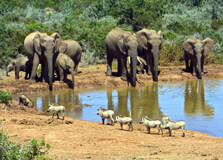
About Addo Elephant National Park Addo Elephant National Park is a renowned wildlife reserve located near Port Elizabeth in the Eastern Cape province of South Africa. The park was established in 1931 to protect the last remaining 11 African elephants in the area. Today, it is home to over 600 elephants as well as other wildlife species. Location and Geographical Overview The Addo Elephant National Park spans across an area of approximately 1,640 square kilometers and is situated about 72 kilometers north of Port Elizabeth. The park encompasses a variety of landscapes including dense forests, rolling hills, and open savannah, providing a diverse habitat for its wildlife inhabitants. Opening and Closing Time The park is open daily from 7:00 am to 6:30 pm. Entry Fee The entry fee for international visitors is R328 per adult and R164 per child. South African citizens pay R76 per adult and R38 per child. Species - Flora/Fauna Availability Aside from elephants, Addo Elephant National Park is home to a wide array of wildlife including lion, buffalo, rhinoceros, leopard, and various antelope species. The park also boasts diverse flora such as spekboom, euphorbias, and a variety of indigenous trees and shrubs. Activities Performed Visitors to the park can enjoy activities such as guided game drives, self-drive safaris, bird watching, hiking trails, and horseback safaris. The park also offers accommodation options for overnight stays. Jeep Safari Charges Jeep safari charges vary depending on the type of safari experience chosen. Prices typically range from R600 to R1200 per person for a guided safari. Age Criterion and Entry Fee Children under the age of 2 enter the park for free. The entry fee for children aged 2-11 is R82 for international visitors and R41 for South African citizens. For visitors aged 12 and above, the adult entry fee applies. Senior Citizen Facilities Senior citizens are eligible for discounted entry fees. South African citizens over the age of 60 can enjoy reduced rates upon presentation of a valid ID. Best Time to Visit The best time to visit Addo Elephant National Park is during the dry winter months from May to September when wildlife congregates around waterholes, making for excellent game viewing opportunities. Nearby Places to Visit Some nearby attractions to Addo Elephant National Park include the Zuurberg Mountain Village, the Daniell Cheetah Project, and the town of Kirkwood known for its citrus orchards. Vehicle Parking Facility The park offers designated parking areas for visitors at various points within the park. Parking is free of charge. Rules and Regulations Visitors are required to follow certain rules and regulations while inside the park such as maintaining a safe distance from wildlife, refraining from feeding the animals, and adhering to speed limits on the roads. How to Reach and Other Related Information Addo Elephant National Park is accessible by car from Port Elizabeth via the N2 highway. The park is approximately a one-hour drive from Port Elizabeth. Alternatively, guided tours and shuttle services are available for visitors without their own transportation.
Explore More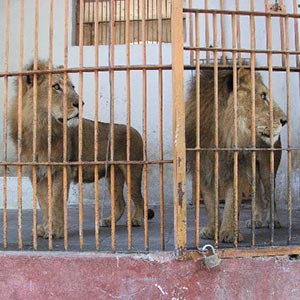
About Giza Zoo The Giza Zoo is a zoological garden located in Giza, a city in Greater Cairo, Egypt. It is one of the oldest and largest zoos in Africa, covering an area of approximately 80 acres. The zoo is home to a diverse collection of animals, providing visitors with an opportunity to learn about and observe wildlife from around the world. Location and Geographical Overview The Giza Zoo is situated in the heart of Giza, near the famous Giza Pyramids and Sphinx. Its central location makes it easily accessible to both locals and tourists visiting the area. The zoo's lush greenery and well-maintained grounds create a serene environment for both visitors and animals. Open and Closing Time The Giza Zoo is open to the public from 9:00 am to 5:00 pm daily. It is advisable to check the zoo's official website or contact them directly for any changes in operating hours. Entry Fee The entry fee for the Giza Zoo is relatively affordable, making it an accessible attraction for visitors of all ages. The exact entry fee may vary for adults, children, and senior citizens, so it is recommended to check the current rates before planning your visit. Species-Flora/Fauna Availability The Giza Zoo is home to a wide variety of plant and animal species, including mammals, birds, reptiles, and more. Visitors can see exotic animals such as lions, tigers, elephants, giraffes, and many others up close in their natural habitats within the zoo. Activities Performed Visitors to the Giza Zoo can enjoy a range of activities, including guided tours, animal feedings, educational programs, and special events. The zoo also offers opportunities for photography and interaction with some of the animals under supervision. Jeep Safari Charges While the Giza Zoo does not offer jeep safaris, visitors can explore the zoo on foot or through guided tours. The zoo's walking paths and trails provide a unique and immersive experience to observe the animals in a natural setting. Age Criterion for Male, Female, Children, and Their Entry Fee The Giza Zoo may have different entry fees based on age and gender categories. It is recommended to inquire about the specific criteria and rates for males, females, and children before planning your visit. Senior Citizen Facilities The Giza Zoo provides facilities and accommodations for senior citizens to ensure their comfort and enjoyment during their visit. These may include seating areas, restrooms, and easy accessibility throughout the zoo grounds. Best Time to Visit The best time to visit the Giza Zoo is during the cooler months of the year, typically from October to April. The moderate temperatures make it more comfortable to explore the zoo and observe the animals in their habitats. Nearby Places to Visit While visiting the Giza Zoo, visitors can explore other nearby attractions such as the Giza Pyramids, the Great Sphinx, and the Egyptian Museum. These iconic landmarks offer a unique insight into Egypt's rich history and culture. Vehicle Parking Facility The Giza Zoo provides ample parking facilities for visitors arriving by car. It is advisable to follow the zoo's parking guidelines and regulations to ensure a smooth and hassle-free experience during your visit. Rules and Regulations Visitors to the Giza Zoo are expected to adhere to certain rules and regulations to ensure the safety and well-being of the animals and other visitors. These may include refraining from feeding the animals, littering, or causing any disturbance within the zoo premises. How to Reach and Other Related Information The Giza Zoo is easily accessible by public transportation, including buses, taxis, and private cars. Visitors can also opt for guided tours or travel packages that include a visit to the zoo as part of their itinerary. It is advisable to plan your visit in advance and check for any updates or changes in operating hours or entry requirements before arriving at the zoo.
Explore More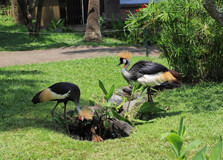
Bali Bird Park is a world-class aviary and tourist attraction located in Gianyar, Bali. It is home to over 1,000 birds from more than 250 different species, making it one of the largest and most diverse bird parks in the world. The park is designed to replicate the natural habitats of the birds, providing them with ample space to fly and thrive. Location and Geographical Overview The Bali Bird Park is situated in the village of Batubulan, Gianyar, on the island of Bali in Indonesia. It is conveniently located just a short drive away from popular tourist destinations like Ubud and Sanur, making it easily accessible for visitors from all over the island. Opening and Closing Time The Bali Bird Park is open every day from 9:00 AM to 5:30 PM, including public holidays. Visitors are advised to arrive early to make the most of their visit and to avoid the crowds. Entry Fee The entry fee for adults is IDR 385,000, for children aged 2-12 years is IDR 192,500, and for senior citizens is IDR 385,000. Children under 2 years old can enter for free. The entry fee includes access to all bird exhibits and shows within the park. Species Flora/Fauna Availability At Bali Bird Park, visitors can encounter a wide variety of bird species, including parrots, owls, eagles, flamingos, and more. The park is also home to various species of flora and fauna, adding to the overall experience of being immersed in a tropical paradise. Activities Performed Visitors to the Bali Bird Park can enjoy a range of activities, such as bird feeding, bird shows, and interactive exhibits. There are also opportunities for photography, where guests can capture stunning moments with the colorful birds in their natural habitat. Jeep Safari Charges For an additional fee, visitors can experience the Bali Bird Park Jeep Safari, where they can explore the park's grounds in a safari-style vehicle. This unique experience allows guests to get up close and personal with the birds and other wildlife in an exciting and immersive way. Age Criterion and Entry Fee The entry fee for adults is IDR 385,000, for children aged 2-12 years is IDR 192,500, and for senior citizens is IDR 385,000. Children under 2 years old can enter for free. Senior Citizen Facilities Senior citizens visiting the Bali Bird Park can enjoy special facilities, such as discounted entry fees and accessible pathways throughout the park. The staff are also trained to assist elderly guests and ensure they have a comfortable and enjoyable visit. Best Time to Visit The best time to visit the Bali Bird Park is during the early morning or late afternoon when the birds are most active. This is also a great time to avoid the heat and the crowds, allowing for a more relaxed and enjoyable experience. Nearby Places to Visit While visiting the Bali Bird Park, visitors can also explore other nearby attractions such as the Bali Zoo, Bali Safari Marine Park, and the cultural villages of Ubud. These destinations offer a diverse range of experiences and are within easy reach of the park. Vehicle Parking Facility The Bali Bird Park provides ample parking space for guests arriving by car or motorbike. The parking area is secure and well-maintained, ensuring the safety of visitors' vehicles while they explore the park. Rules and Regulations Visitors to the Bali Bird Park are required to follow certain rules and regulations to ensure the safety and well-being of the birds and other wildlife. These include not feeding the birds unless authorized, not littering, and respecting the natural habitats of the animals. How to Reach and Other Related Information The Bali Bird Park is easily accessible by car or taxi from popular tourist areas like Ubud and Sanur. Visitors can also opt for public transportation or guided tours to reach the park. It is recommended to check the park's website for the latest information on entry fees, opening hours, and special events. Overall, the Bali Bird Park offers a unique and immersive experience for visitors of all ages, allowing them to connect with nature and appreciate the beauty of birds from around the world. Whether you are a bird enthusiast or just looking for a fun and educational day out, the Bali Bird Park is a must-visit destination in Bali.
Explore More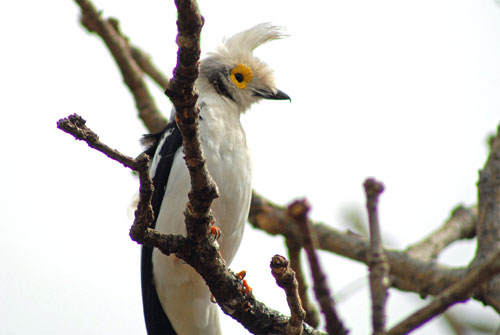
About Niumi National Park Niumi National Park is a stunning wildlife reserve located in the village of Niumi, situated in the North Bank Region of The Gambia. The park covers an area of approximately 4,940 acres and is renowned for its diverse flora and fauna, making it a popular destination for nature lovers and wildlife enthusiasts. Location and Geographical Overview Niumi National Park is located in the village of Niumi in the North Bank Region of The Gambia. The park is bordered by the Gambia River to the west and offers breathtaking views of the surrounding landscape. The park is easily accessible by road, with well-maintained routes leading to the entrance. Opening and Closing Time The park is open to visitors from 8:00 am to 6:00 pm daily, allowing ample time to explore the beauty of the park and observe its wildlife in their natural habitat. Entry Fee The entry fee for Niumi National Park is $10 for adults and $5 for children under the age of 12. Senior citizens above the age of 60 are granted free entry to the park. Species - Flora/Fauna Availability Niumi National Park is home to a wide variety of plant and animal species. The park is rich in flora, with towering trees, colorful flowers, and lush greenery throughout the area. Visitors can also spot a diverse range of fauna, including monkeys, antelopes, birds, and even crocodiles in the park's rivers and waterways. Activities Performed Visitors to Niumi National Park can engage in a range of activities, including guided nature walks, birdwatching, picnicking, and wildlife photography. The park also offers jeep safaris for those looking to explore the park's vast landscape and spot wildlife up close. Jeep Safari Charges The charges for a jeep safari at Niumi National Park are $50 per person. The safari includes a guided tour of the park, providing visitors with the opportunity to see wildlife in their natural habitat and learn about the park's conservation efforts. Age Criterion and Entry Fee For male visitors, the entry fee is $10, while female visitors are required to pay $10 as well. Children under the age of 12 can enter the park for $5. Senior citizens above the age of 60 are granted free entry to the park. Senior Citizen Facilities Niumi National Park offers special facilities for senior citizens, including designated seating areas, wheelchair access, and assistance from park staff. Senior citizens can enjoy the beauty of the park at their own pace and in comfort. Best Time to Visit The best time to visit Niumi National Park is during the dry season, which runs from November to May. During this time, the weather is pleasant, and wildlife sightings are more frequent. The park is also less crowded, allowing visitors to enjoy a peaceful and immersive experience in nature. Nearby Places to Visit There are several nearby attractions worth visiting while in the area, including the historic village of Juffureh, where visitors can learn about the region's rich cultural heritage and its ties to the transatlantic slave trade. The stunning beaches of Sanyang and the bustling markets of Banjul are also within driving distance from the park. Vehicle Parking Facility Niumi National Park provides ample parking facilities for visitors arriving by car. There are designated parking areas near the park entrance, ensuring convenient access to the park for all guests. Rules and Regulations Visitors to Niumi National Park are required to follow a set of rules and regulations to ensure the safety of the park's wildlife and preserve its natural habitat. Some of the rules include refraining from littering, feeding the animals, and making loud noises that may disturb the wildlife. Additionally, visitors are required to stay on designated walking paths and follow the guidance of park staff at all times. How to Reach and Other Related Information Niumi National Park can be easily reached by road, with well-maintained routes leading to the park entrance. The park is approximately a 2-hour drive from Banjul, the capital city of The Gambia. Visitors can also arrange for guided tours and transportation services to and from the park through local tour operators. For more information on visiting Niumi National Park, visitors can contact the park office or check the official website for updates on opening hours, entry fees, and special events.
Explore More
About Kenai Fjords National Park Kenai Fjords National Park is a breathtaking national park located in Alaska, USA. Established in 1980, the park covers an area of approximately 669,983 acres and is known for its stunning glaciers, fjords, and abundant wildlife. The park is named after the numerous fjords carved by glaciers in the Kenai Peninsula. Location and Geographical Overview The park is located near the town of Seward, on the southeastern coast of Alaska. It is surrounded by the Chugach National Forest to the north and the Gulf of Alaska to the south. The park's main attraction is the Harding Icefield, one of the largest icefields in the United States, which feeds over 38 glaciers that flow into the surrounding fjords. Opening and Closing Time The park is open year-round, but some areas may be inaccessible during the winter months due to snow and ice. The visitor center is typically open from 9 am to 5 pm during the summer months, but hours may vary depending on the season. Entry Fee There is an entrance fee of $15 per person for a 7-day pass to Kenai Fjords National Park. This fee helps support park maintenance and conservation efforts. Species-Flora/Fauna Availability The park is home to a diverse range of flora and fauna, including bears, moose, sea otters, seabirds, and marine mammals. Visitors may also spot whales, eagles, and puffins during their visit. The park's unique ecosystem supports a variety of plant life, from wildflowers to ancient forests. Activities Performed Visitors to Kenai Fjords National Park can enjoy a wide range of activities, including hiking, wildlife viewing, boat tours, kayaking, and camping. Guided tours are available for those looking to learn more about the park's history, geology, and wildlife. Jeep Safari Charges Jeep safari tours are not available within the park, but visitors can explore the park's rugged terrain by foot, boat, or kayak. Rental car services are available in nearby towns for those looking to explore the area by vehicle. Age Criterion and Entry Fee There is no age restriction for entry into the park, but children under 16 are admitted for free. Adult entry fees apply to visitors 16 and older. Senior citizens may be eligible for discounted or free entry, depending on their age and residency status. Senior Citizen Facilities Senior citizens visiting Kenai Fjords National Park may be eligible for discounted entry fees, as well as access to special programs and events tailored to their interests. The park offers wheelchair-accessible facilities and services to accommodate visitors with limited mobility. Best Time to Visit The best time to visit Kenai Fjords National Park is during the summer months, from May to September, when the weather is milder and many of the park's activities are available. The park is less crowded during the shoulder seasons of spring and fall, making it a great time to visit for those looking for a more peaceful experience. Nearby Places to Visit While visiting Kenai Fjords National Park, visitors can explore the nearby town of Seward, known for its fishing charters, hiking trails, and scenic harbor. The Alaska SeaLife Center, a marine research facility and aquarium, is also located in Seward and offers educational programs and exhibits. Vehicle Parking Facility Parking is available at the park's visitor center and various trailheads throughout the park. Visitors are encouraged to park in designated areas and follow all posted parking regulations to avoid fines or towing. Rules and Regulations Visitors to Kenai Fjords National Park are required to follow all park rules and regulations, including staying on designated trails, respecting wildlife and natural resources, and properly disposing of trash. Camping permits may be required for overnight stays, and open fires are prohibited in some areas of the park. How to Reach and Other Related Information Kenai Fjords National Park is accessible by car from Anchorage, Alaska's largest city, which is approximately a 2.5-hour drive away. Visitors can also reach the park by train or bus from Anchorage or by boat from Seward. For more information on park activities, guided tours, and current conditions, visitors can contact the park's visitor center or visit the official park website. Plan your trip to Kenai Fjords National Park to experience the beauty of Alaska's glaciers, fjords, and wildlife in a pristine natural setting.
Explore More
About Kobuk Valley National Park Kobuk Valley National Park is located in Northwestern Alaska, covering over 1.7 million acres of diverse landscapes including sand dunes, boreal forests, rivers, and the Baird Mountains. It was established as a national park in 1980 to protect the unique ecosystem and cultural heritage of the area. Location and Geographical Overview The park is situated about 25 miles north of the Arctic Circle, near the village of Kotzebue. It is accessible only by air or by the Kobuk River during the short summer season. The park is known for its vast sand dunes, the Kobuk River, and the migration of the Western Arctic Caribou Herd. Open and Closing Time Kobuk Valley National Park is open year-round, but access is limited during the winter months due to extreme weather conditions. The visitor center is usually open from June to August, with varying hours depending on the season. Entry Fee There is no entrance fee to visit Kobuk Valley National Park. Species-Flora/Fauna Availability The park is home to a diverse range of flora and fauna, including caribou, grizzly bears, wolves, and a variety of bird species. The sand dunes are also unique in that they support plant life not usually found in such sandy environments. Activities Performed Visitors to Kobuk Valley National Park can enjoy a range of activities, including hiking, camping, fishing, birdwatching, and river trips. The park is also a popular destination for wilderness photography and exploring the unique sand dunes. Jeep Safari Charges There are no official jeep safari tours offered within Kobuk Valley National Park. However, visitors can explore the park by foot, boat, or air charter. Age Criterion for Male, Female, Children and Their Entry Fee There are no age restrictions for visiting Kobuk Valley National Park, and entry is free for all visitors. Senior Citizen Facilities Seniors visiting the park can enjoy the same activities and facilities as other visitors. The park does not have specific facilities or programs exclusively for senior citizens. Best Time to Visit The best time to visit Kobuk Valley National Park is during the summer months, from June to August, when the weather is milder and more activities are available. The caribou migration usually occurs in late June and early July, making it a popular time for wildlife viewing. Nearby Places to Visit While in the area, visitors can also explore the nearby Gates of the Arctic National Park and Preserve, Noatak National Preserve, and the village of Kotzebue for a glimpse into traditional Inupiat culture. Vehicle Parking Facility There are limited parking facilities at the park entrance and near the visitor center. Visitors are encouraged to carpool or use alternative transportation when possible to reduce congestion and environmental impact. Rules and Regulations Visitors to Kobuk Valley National Park are required to follow Leave No Trace principles, respect wildlife and cultural resources, and obtain any necessary permits for camping or backcountry activities. Hunting and fishing regulations also apply within the park boundaries. How to Reach and Other Related Information Access to Kobuk Valley National Park is primarily by air from Anchorage to Kotzebue, followed by a charter flight or boat trip to the park. There are no roads leading directly to the park, so visitors must plan ahead for transportation and accommodations. It is recommended to check with the park's visitor center for current information on access and conditions before planning a trip. Overall, Kobuk Valley National Park offers a unique wilderness experience for visitors looking to explore the remote and stunning landscapes of Northwestern Alaska. From the migrating caribou to the towering sand dunes, the park is a true gem for nature enthusiasts and adventurers alike.
Explore More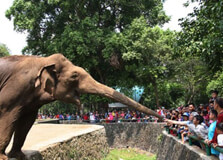
Ragunan Zoo is a popular zoological park located in Pasar Minggu, South Jakarta, Indonesia. It covers an area of approximately 140 hectares and is home to over 3,600 species of animals, making it one of the largest zoos in Southeast Asia. The zoo was first established in 1864 during the Dutch colonial era and has been a favorite destination for locals and tourists alike ever since. Location and Geographical Overview Ragunan Zoo is situated in a lush, tropical setting at the southern end of Jakarta. It is easily accessible by public transportation and is surrounded by greenery, providing a peaceful retreat from the hustle and bustle of the city. The zoo is located near the Ragunan bus terminal, making it convenient for visitors to reach. Opening and Closing Time The zoo is open to visitors from 7:30 am to 5:00 pm every day, including weekends and public holidays. It is recommended to arrive early to avoid crowds and make the most of your visit. Entry Fee The entry fee for Ragunan Zoo is very affordable, making it a great option for families and budget travelers. The fee for adults is IDR 4,000, while children under 2 years old can enter for free. Foreign visitors may have a slightly higher entry fee. Species-Flora/Fauna Availability Ragunan Zoo is home to a wide variety of flora and fauna, including elephants, tigers, orangutans, and Komodo dragons. The zoo is divided into several zones, each showcasing different species of animals in their natural habitats. Visitors can also explore the botanical garden and see a diverse collection of plants from around the world. Activities Performed Visitors to Ragunan Zoo can enjoy a range of activities, including animal feeding sessions, educational tours, and animal shows. The zoo also offers guided tours and workshops for children, making it an ideal destination for families to learn about wildlife conservation. Jeep Safari Charges Ragunan Zoo offers a unique jeep safari experience for visitors who want to explore the vast grounds of the zoo in style. The jeep safari charges vary depending on the length of the tour and the number of participants, but prices are reasonable and inclusive of a knowledgeable guide. Age Criterion and Entry Fee Children under 2 years old can enter Ragunan Zoo for free. The entry fee for adults is IDR 4,000. There may be special rates for students and senior citizens, so it is advisable to check with the zoo administration for more information on ticket prices. Senior Citizen Facilities Ragunan Zoo offers special facilities for senior citizens, including discounted entry fees and wheelchair access to all areas of the zoo. Visitors over 60 years old can enjoy a leisurely stroll through the park and take advantage of designated rest areas. Best Time to Visit The best time to visit Ragunan Zoo is during the early morning hours when the animals are most active and the weather is cooler. Weekdays are generally less crowded than weekends, so plan your visit accordingly to avoid long queues and enjoy a more peaceful experience. Nearby Places to Visit There are several attractions near Ragunan Zoo that visitors can explore, including the Ragunan Orchid Garden, Taman Mini Indonesia Indah, and the Ragunan Freshwater Aquarium. These destinations offer additional opportunities for nature lovers and cultural enthusiasts to enjoy their time in Jakarta. Vehicle Parking Facility Ragunan Zoo provides ample parking space for visitors who choose to drive to the park. The parking fee is affordable, and the facilities are well-maintained, ensuring a hassle-free experience for guests with private vehicles. Rules and Regulations Visitors to Ragunan Zoo are expected to follow certain rules and regulations to ensure the safety and well-being of the animals and other visitors. Some guidelines include not feeding the animals, refraining from littering, and not disturbing the animals in their habitats. It is also recommended to maintain a distance from the animals and to respect their space. How to Reach and Other Related Information Ragunan Zoo is easily accessible by public transportation, including buses, taxis, and ride-sharing services. Visitors can also use online maps and GPS to navigate to the zoo from their location. The zoo administration provides information on their website, including upcoming events, special exhibitions, and conservation programs that visitors can participate in. Overall, Ragunan Zoo offers a unique and educational experience for visitors of all ages, with its diverse collection of animals, beautiful gardens, and engaging activities. Whether you are a nature lover, animal enthusiast, or simply looking for a fun day out with family and friends, Ragunan Zoo is a must-visit destination in Jakarta.
Explore More
The Sinharaja Forest Reserve is a national park and a biodiversity hotspot located in the southwestern part of Sri Lanka. It is one of the country's last remaining rainforests and is a UNESCO World Heritage Site due to its rich biodiversity and unique ecology. Location and Geographical Overview The Sinharaja Forest Reserve is situated in the Galle District of Sri Lanka, covering an area of approximately 11,187 hectares. It is surrounded by several rivers and streams and is known for its dense vegetation and diverse wildlife. Open and Closing Time The Sinharaja Forest Reserve is open to visitors from 6:00 AM to 6:00 PM daily. It is recommended to visit early in the morning to experience the best of the wildlife and bird watching opportunities. Entry Fee There is an entry fee for visiting the Sinharaja Forest Reserve, which varies for local and foreign tourists. The fee may also include charges for guided tours and activities within the park. Species-Flora/Fauna Availability Sinharaja Forest Reserve is home to a wide variety of plant and animal species, including many endemic species that are found only in this region. Some of the notable flora includes valuable medicinal plants, orchids, and hardwood trees. The forest is also a haven for many bird species, reptiles, and amphibians. Activities Performed Visitors to the Sinharaja Forest Reserve can partake in a range of activities, such as bird watching, nature walks, trekking, and camping. Guided tours are available for those interested in learning more about the biodiversity and conservation efforts in the park. Jeep Safari Charges Jeep safaris are not allowed within the Sinharaja Forest Reserve to minimize disturbance to the wildlife and ecosystem. However, guided walks and treks are available for visitors to explore the park on foot. Age Criterion for Male, Female, Children and their Entry Fee Entry fees for the Sinharaja Forest Reserve may vary based on the age and gender of the visitors. Children and senior citizens may be eligible for discounted rates, while students and local residents may also receive special pricing. Senior Citizen Facilities The Sinharaja Forest Reserve offers facilities for senior citizens, such as rest areas, benches, and accessible paths for those with mobility issues. Special arrangements can be made for elderly visitors to ensure their comfort and enjoyment during their visit. Best Time to Visit The best time to visit the Sinharaja Forest Reserve is during the dry season, which typically runs from December to April. This period offers the most favorable weather conditions for exploring the park and spotting wildlife in their natural habitat. Nearby Places to Visit There are several attractions near the Sinharaja Forest Reserve that visitors can explore, including historical sites, waterfalls, and picturesque villages. Some popular nearby destinations include Udawalawe National Park, Galle Fort, and Horton Plains National Park. Vehicle Parking Facility There is a designated parking area near the entrance of the Sinharaja Forest Reserve where visitors can park their vehicles. It is recommended to arrive early to secure a parking spot, especially during peak tourist seasons. Rules and Regulations Visitors to the Sinharaja Forest Reserve are required to follow certain rules and regulations to protect the park's ecosystem and wildlife. Some common guidelines include staying on designated trails, avoiding littering, and refraining from feeding or disturbing the animals. How to Reach and Other Related Information The Sinharaja Forest Reserve can be reached by road from major cities like Colombo and Galle. Visitors can also take public transportation or hire a private vehicle to reach the park entrance. It is advisable to plan ahead and make reservations for guided tours or accommodations in advance. Overall, the Sinharaja Forest Reserve is a must-visit destination for nature lovers and wildlife enthusiasts seeking to experience the beauty and diversity of Sri Lanka's tropical rainforest ecosystem.
Explore More
About Tijuca National Park Tijuca National Park is a protected area located in the city of Rio de Janeiro, Brazil. It is considered one of the largest urban rainforests in the world, covering an area of approximately 32 square kilometers. The park is home to a diverse range of flora and fauna, as well as stunning natural landscapes and waterfalls. Location and Geographical Overview Tijuca National Park is situated in the Tijuca Massif, a mountain range in the heart of Rio de Janeiro. The park is easily accessible from the city center and is a popular destination for both locals and tourists seeking a break from the hustle and bustle of urban life. Open and Closing Time The park is open from 8:00 AM to 5:00 PM every day of the week. Entry Fee There is no entry fee to visit Tijuca National Park, making it a budget-friendly option for nature enthusiasts. Species-Flora/Fauna Availability The park is home to a wide variety of plant and animal species, including endangered mammals like the golden lion tamarin and the woolly spider monkey. Visitors can also spot exotic birds, butterflies, and reptiles while exploring the park's trails. Activities Performed Visitors to Tijuca National Park can enjoy a range of activities, including hiking, birdwatching, picnicking, and swimming in natural pools. The park also offers guided tours and educational programs for those interested in learning more about its biodiversity and conservation efforts. Jeep Safari Charges For those looking to explore the park in style, jeep safari tours are available for an additional fee. Prices may vary depending on the duration and route of the tour. Age Criterion and Entry Fee There is no age criterion for entry into Tijuca National Park. However, visitors are required to pay a small fee for parking and any additional services they may use within the park. Senior Citizen Facilities Tijuca National Park offers facilities for senior citizens, including accessible trails, rest areas, and guided tours tailored to their needs. Discounted rates may also be available for elderly visitors. Best Time to Visit The best time to visit Tijuca National Park is during the dry season, which falls between May and September. During this time, the weather is more pleasant for outdoor activities, and the trails are less crowded with tourists. Nearby Places to Visit Located in the heart of Rio de Janeiro, Tijuca National Park is close to other popular attractions such as Christ the Redeemer, Sugarloaf Mountain, and the Botanical Garden. Visitors can easily combine a visit to the park with sightseeing in the city. Vehicle Parking Facility Tijuca National Park offers a parking facility for visitors arriving by car. The parking lot is secure and well-maintained, providing easy access to the park's entrance. Rules and Regulations Visitors to Tijuca National Park are expected to follow a set of rules and regulations to ensure the protection of the environment and the safety of all visitors. These rules include staying on marked trails, refraining from littering, and respecting wildlife and plants. How to Reach and Other Related Information Tijuca National Park can be reached by public transportation, taxi, or private car from the city of Rio de Janeiro. The park has clear signage and information boards to help visitors navigate its trails and attractions. For more information, visitors can visit the official website of the park or contact the park administration directly.
Explore More
Ujung Kulon National Park is located at the western tip of Java, Indonesia, encompassing a vast area of 1,206 square kilometers. Established in 1980, it was declared a UNESCO World Heritage Site in 1991 in recognition of its natural beauty and biodiversity. The park is renowned for being home to the critically endangered Javan rhinoceros, as well as a variety of other plant and animal species. Location and Geographical Overview Ujung Kulon National Park is situated in the Banten province of Indonesia, specifically on the southwestern tip of Java. It is bordered by the Indian Ocean to the south and the Sunda Strait to the west, providing breathtaking coastal views. The park consists of a combination of tropical rainforest, mangrove forests, and marine ecosystems, making it a haven for a diverse range of flora and fauna. Open and Closing Time The park is open to visitors from 7:00 AM to 5:00 PM daily. It is recommended to plan your visit accordingly to make the most of your time exploring the natural beauty of Ujung Kulon National Park. Entry Fee The entry fee for Ujung Kulon National Park varies depending on the age and nationality of visitors. Indonesian citizens typically have a lower entry fee compared to international tourists. It is advisable to check the official website or contact the park authorities for the most up-to-date information on entry fees. Species-Flora/Fauna Availability Ujung Kulon National Park is home to a rich variety of flora and fauna. Some of the key species found in the park include the Javan rhinoceros, Javan pangolin, Javan leopard, and green peafowl. The park also boasts a diverse range of plant life, including various species of trees, flowers, and ferns. Activities Performed Visitors to Ujung Kulon National Park can enjoy a range of activities to immerse themselves in the natural surroundings. Popular activities include hiking through the rainforest, bird watching, snorkeling or diving in the crystal-clear waters, and taking a boat tour to explore the coastal areas of the park. Jeep Safari Charges For those looking to explore the park in a more adventurous way, jeep safaris are available for an additional fee. The charges for jeep safaris vary depending on the duration and route chosen. It is recommended to book in advance to secure your spot and avoid disappointment. Age Criterion and Entry Fee There may be age criteria for entry and corresponding entry fees for Ujung Kulon National Park. The specific requirements for males, females, and children may vary, so it is advisable to check with the park authorities for accurate information on age criteria and entry fees. Senior Citizen Facilities Ujung Kulon National Park aims to provide facilities for senior citizens to ensure their comfort and enjoyment during their visit. Facilities such as designated seating areas, accessible paths, and rest areas may be available to accommodate the needs of elderly visitors. Best Time to Visit The best time to visit Ujung Kulon National Park is during the dry season, which typically falls between April and October. During this period, the weather is more favorable for outdoor activities, and wildlife sightings are more common. It is advisable to plan your visit accordingly to make the most of your experience at the park. Nearby Places to Visit While exploring Ujung Kulon National Park, visitors can also explore nearby attractions in the surrounding area. Some popular destinations include the pristine beaches of Peucang Island, the historical sites in the town of Labuhan, and the traditional villages of the Baduy people. These nearby places offer additional opportunities to immerse yourself in the culture and natural beauty of the region. Vehicle Parking Facility Ujung Kulon National Park provides vehicle parking facilities for visitors who choose to drive to the park. It is recommended to follow the designated parking guidelines and instructions to ensure the safety and security of your vehicle during your visit. Parking fees may apply, so it is advisable to check with the park authorities for more information. Rules and Regulations Visitors to Ujung Kulon National Park are required to adhere to certain rules and regulations to protect the environment and wildlife within the park. Some common regulations include not littering, not feeding the animals, and staying on designated trails. It is important to respect the natural surroundings and follow the guidelines set by the park authorities to ensure a safe and enjoyable experience for all visitors. How to Reach and Other Related Information Ujung Kulon National Park can be reached by various transportation options, including private vehicles, public buses, and guided tours. The nearest major city to the park is Jakarta, which is approximately a 4-hour drive away. It is recommended to plan your transportation in advance and make any necessary arrangements to ensure a smooth journey to the park. For more information on how to reach Ujung Kulon National Park and other related details, visitors can consult the official park website or contact the park authorities directly.
Explore More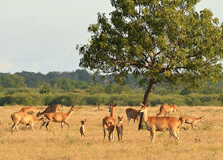
Baluran National Park is a stunning natural gem located on the island of Java, Indonesia. Often referred to as the "Little Africa of Java" due to its savannah landscape and diverse wildlife, the park covers an area of approximately 25,000 hectares. Established in 1980, Baluran National Park is a must-visit destination for nature lovers, adventure enthusiasts, and wildlife photographers. Location and Geographical Overview Located in East Java, Baluran National Park is situated near the town of Banyuwangi. The park is bordered by the Bali Strait to the east, the city of Situbondo to the west, and the Madura Strait to the north. The landscape of Baluran National Park is characterized by a unique combination of savannah grasslands, mangrove forests, and lowland forests, making it a haven for a wide variety of plant and animal species. Open and Closing Time The park is open to visitors from 8:00 AM to 5:00 PM every day, including weekends and public holidays. Entry Fee The entry fee for Baluran National Park is IDR 5,000 for Indonesian citizens and IDR 150,000 for foreign tourists. Additional fees may apply for certain activities or attractions within the park. Species-Flora/Fauna Availability Baluran National Park is home to a diverse array of plant and animal species, including endangered species such as the Javanese water buffalo, Javan rusa deer, and green peafowl. The park also boasts a rich variety of flora, including rare orchids, mangrove trees, and acacia species. Activities Performed Visitors to Baluran National Park can engage in a variety of activities, such as hiking, bird watching, wildlife photography, and camping. The park also offers guided jeep safaris through its savannah grasslands, allowing visitors to get up close and personal with the park's wildlife. Jeep Safari Charges The cost of a jeep safari in Baluran National Park varies depending on the duration and route of the safari. Prices typically start at around IDR 300,000 per person for a standard safari tour. Age Criterion and Entry Fee Children under the age of 5 can enter the park free of charge. For children aged 6-12, the entry fee is IDR 2,500. The standard entry fee of IDR 5,000 applies to individuals aged 13 and above. Senior Citizen Facilities Senior citizens aged 60 and above can avail of discounted entry fees and may be eligible for special accommodations or assistance within the park. It is advised to inquire about senior citizen facilities upon arrival at the park entrance. Best Time to Visit The best time to visit Baluran National Park is during the dry season, which typically falls between April and November. This is the ideal time for wildlife spotting, hiking, and enjoying the park's outdoor activities. However, visitors should be prepared for hot temperatures and limited rainfall during this period. Nearby Places to Visit Located in close proximity to Baluran National Park are several other popular tourist destinations, including the Ijen Crater, Alas Purwo National Park, and the town of Banyuwangi. Travelers can easily explore these nearby attractions and make the most of their visit to the region. Vehicle Parking Facility Baluran National Park offers ample parking facilities for visitors arriving by private vehicle. There is a designated parking area near the park entrance where visitors can safely park their cars or motorcycles during their visit. Rules and Regulations Visitors to Baluran National Park are required to follow certain rules and regulations to ensure the preservation of the park's natural beauty and wildlife. Some common rules include refraining from littering, respecting wildlife and vegetation, and obeying park staff instructions. It is essential to adhere to these guidelines to promote sustainable tourism and conservation efforts. How to Reach and Other Related Information Baluran National Park can be reached by taking a flight to Blimbingsari Airport in Banyuwangi or by road from nearby cities such as Surabaya or Denpasar. From Banyuwangi, visitors can hire a taxi or rent a car to reach the park entrance. Local tour operators also offer guided tours to Baluran National Park, making it easy for travelers to explore the area. Before visiting, it is recommended to check the weather conditions, park regulations, and any travel advisories to ensure a smooth and enjoyable experience. With its breathtaking landscapes, diverse wildlife, and array of activities, Baluran National Park promises an unforgettable experience for nature enthusiasts and adventure seekers alike. Whether you're looking to immerse yourself in the beauty of Java's countryside or witness rare animal species in their natural habitat, this national park is a true hidden gem waiting to be explored.
Explore More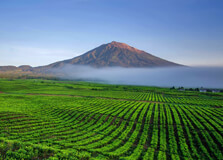
About Kerinci Seblat National Park Kerinci Seblat National Park is a vast national park located in Sumatra, Indonesia. It is one of the largest national parks in Southeast Asia, covering an area of 13,791 square kilometers. The park is named after Mount Kerinci, the highest peak in Sumatra, which is also an active volcano. Established in 1982, Kerinci Seblat National Park is renowned for its rich biodiversity and stunning landscapes. Location and Geographical Overview The Kerinci Seblat National Park is located in the provinces of West Sumatra, Jambi, Bengkulu, and South Sumatra in Indonesia. The park is characterized by its rugged terrain, dense rainforests, rivers, waterfalls, and diverse ecosystems. It is home to a wide range of flora and fauna, including endangered species such as the Sumatran tiger, Sumatran elephant, and Sumatran rhinoceros. Opening and Closing Time The Kerinci Seblat National Park is open to visitors from 8:00 AM to 5:00 PM daily. Entry Fee The entry fee for Kerinci Seblat National Park is $10 for foreign tourists and $5 for domestic tourists. Species-Flora/Fauna Availability Kerinci Seblat National Park is home to a diverse range of flora and fauna. The park is known for its rich biodiversity, with over 4,000 plant species, 300 bird species, and 4,000 animal species. Some of the iconic species found in the park include the Sumatran tiger, Sumatran elephant, and Sumatran rhinoceros. Activities Performed Visitors to Kerinci Seblat National Park can engage in a variety of activities such as hiking, bird watching, wildlife spotting, camping, and nature photography. The park offers several hiking trails of varying difficulty levels, allowing visitors to explore its stunning landscapes and diverse ecosystems. Jeep Safari Charges Jeep safari tours are available in Kerinci Seblat National Park for visitors who wish to explore the park's remote areas and wildlife habitats. The charges for a jeep safari tour vary depending on the duration and itinerary of the tour. Age Criterion and Entry Fee Children under the age of 5 can enter the Kerinci Seblat National Park for free. The entry fee for males and females above the age of 12 is $10 for foreign tourists and $5 for domestic tourists. Senior citizens are eligible for a discounted entry fee of $7. Senior Citizen Facilities Kerinci Seblat National Park offers special facilities for senior citizens, including designated resting areas, easy access trails, and discounted entry fees. The park staff are also available to assist senior citizens with any special requirements they may have. Best Time to Visit The best time to visit Kerinci Seblat National Park is during the dry season, which typically falls between June and September. During this time, the weather is pleasant, making it ideal for outdoor activities such as hiking and wildlife spotting. Nearby Places to Visit There are several nearby attractions that visitors can explore while visiting Kerinci Seblat National Park, including the picturesque Lake Kerinci, the charming town of Sungai Penuh, and the traditional villages of the indigenous Minangkabau people. Vehicle Parking Facility Kerinci Seblat National Park provides ample parking space for visitors who arrive by car or motorcycle. The parking facilities are well-maintained and secure, offering convenience to visitors exploring the park. Rules and Regulations Visitors to Kerinci Seblat National Park are required to abide by the following rules and regulations: Do not litter or disturb the natural environment. Respect the wildlife and do not feed or harm them. Stay on designated trails and do not wander off into restricted areas. Observe and follow the instructions of park staff at all times. Do not make loud noises or play music that may disturb other visitors or wildlife. How to Reach and Other Related Information Kerinci Seblat National Park can be reached by air, land, and sea. The nearest airport to the park is Padang Airport, which is located in West Sumatra. From the airport, visitors can take a bus or taxi to the park. Alternatively, visitors can also reach the park by road from nearby cities such as Jambi and Bengkulu. It is recommended to hire a local guide or join a guided tour for a more enriching experience of the park.
Explore More